
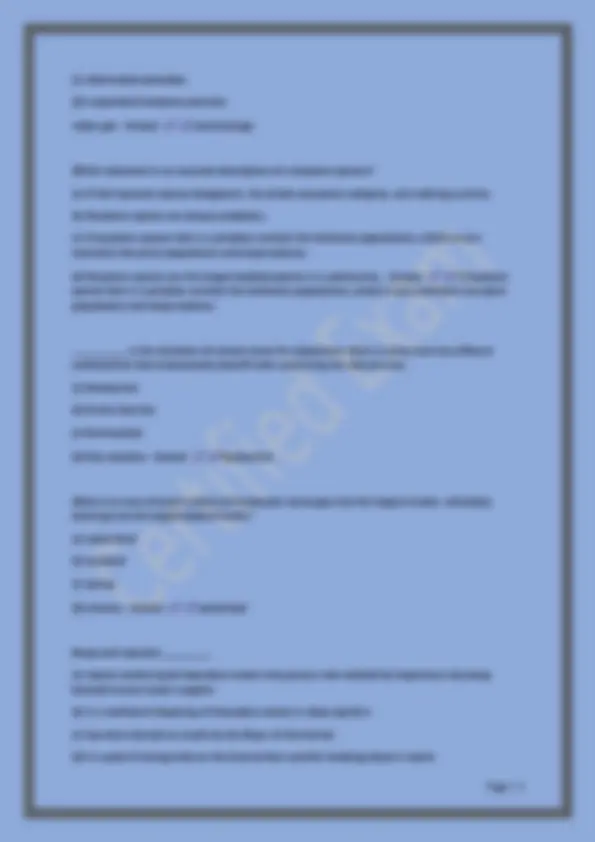
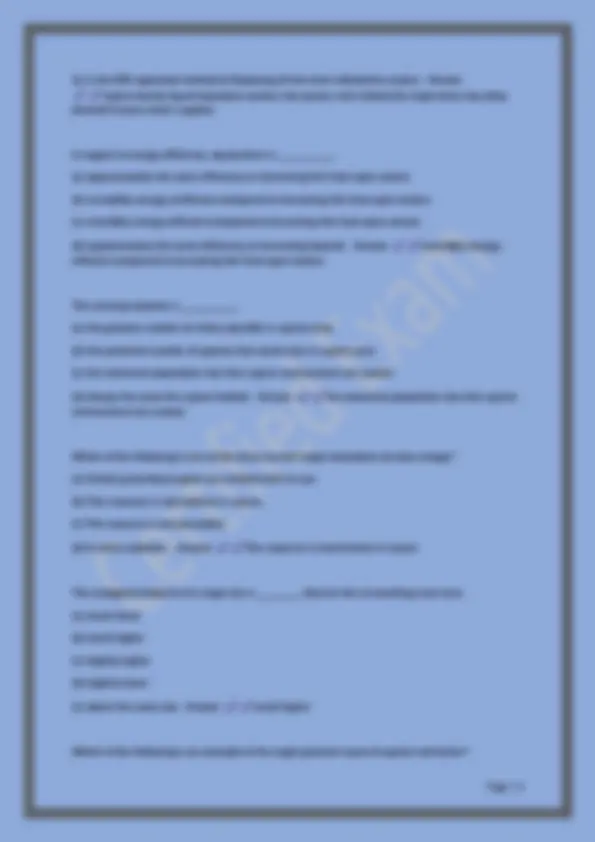
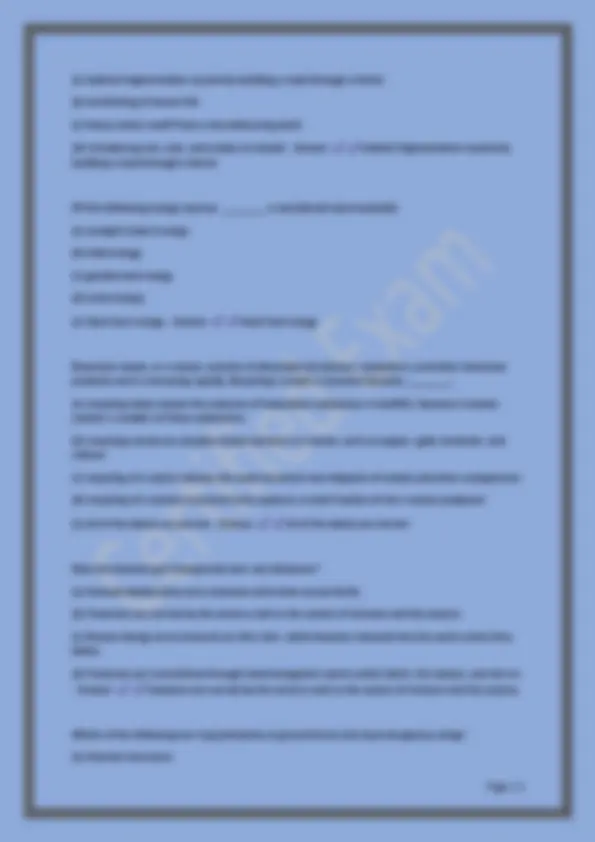
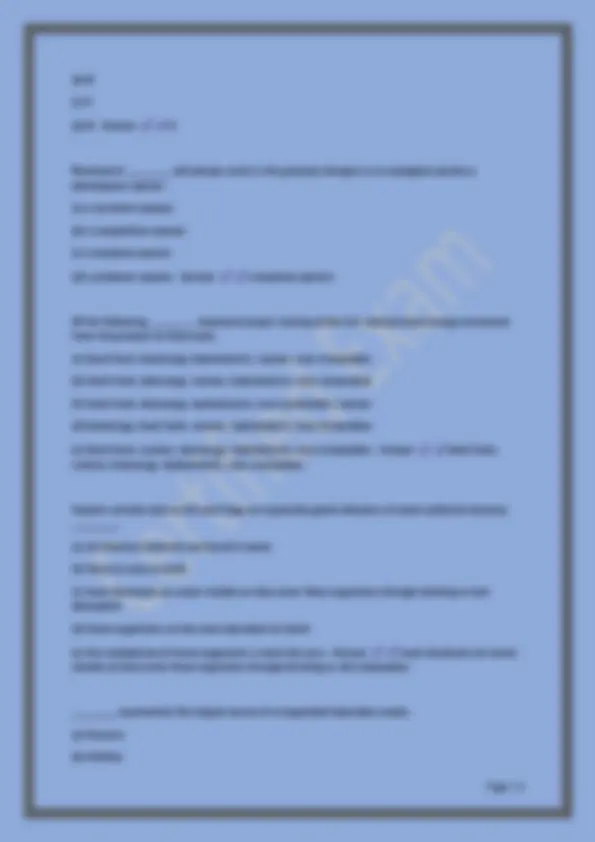
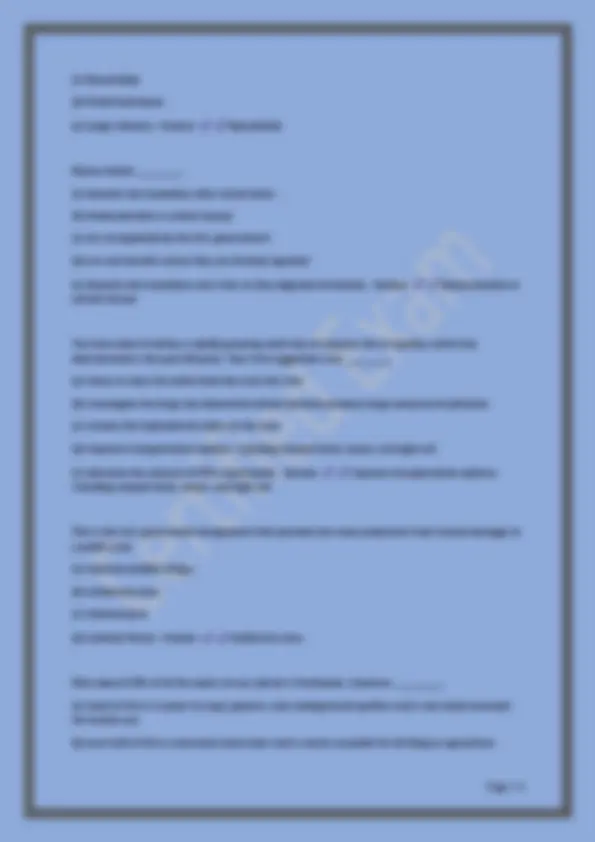
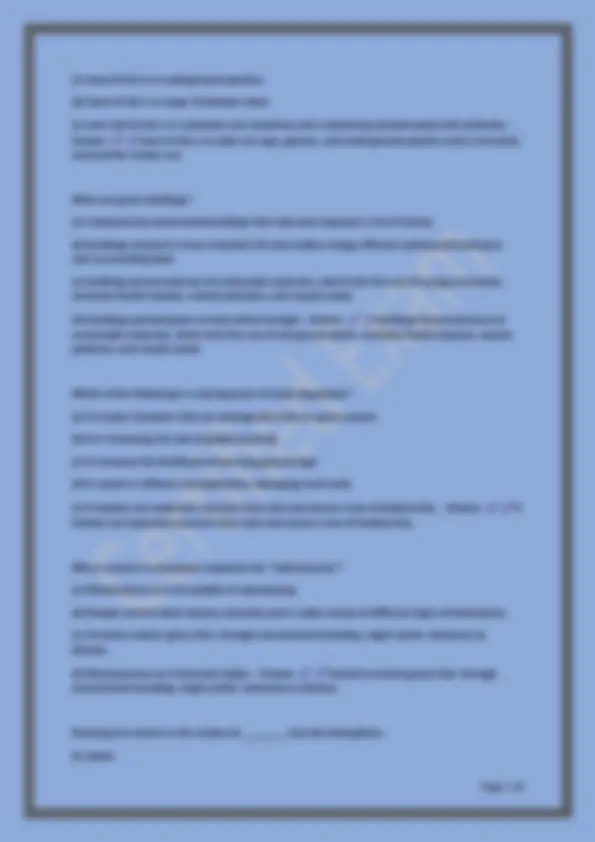
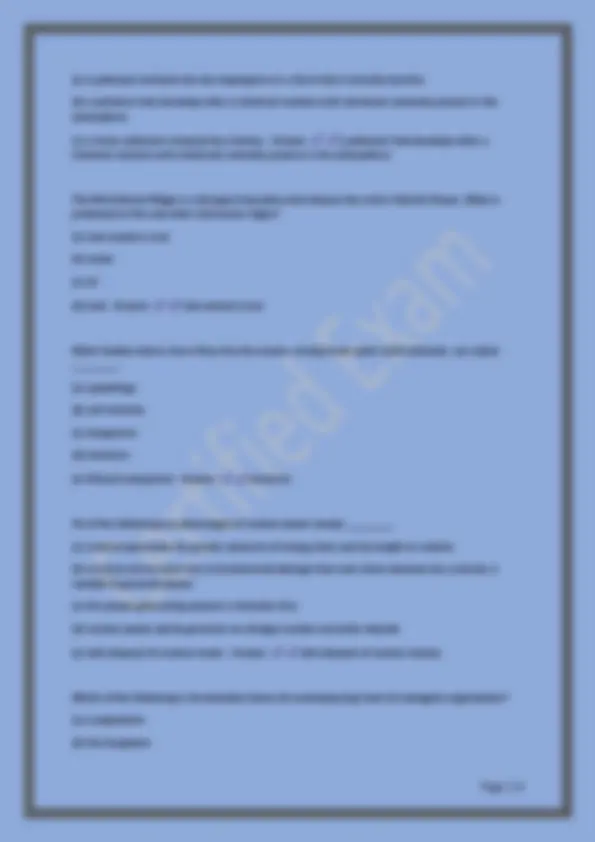
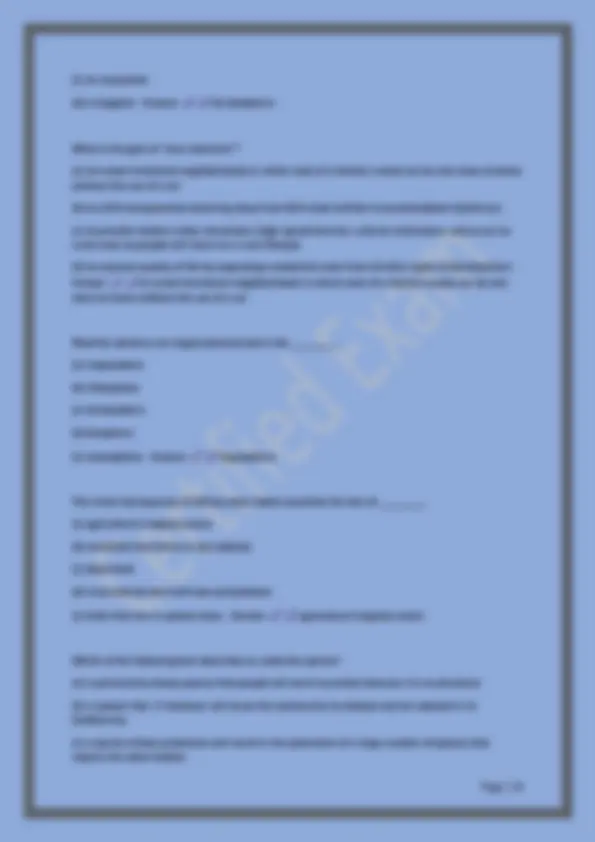
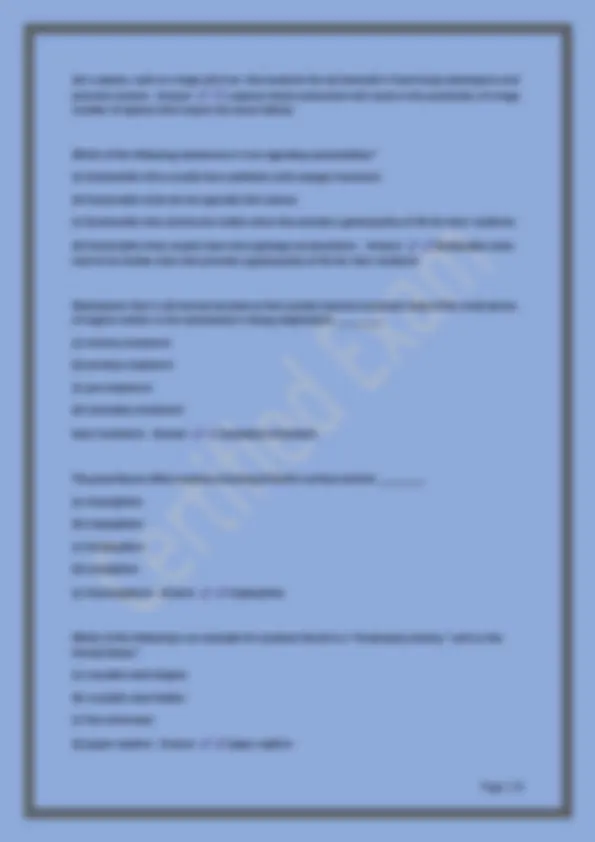
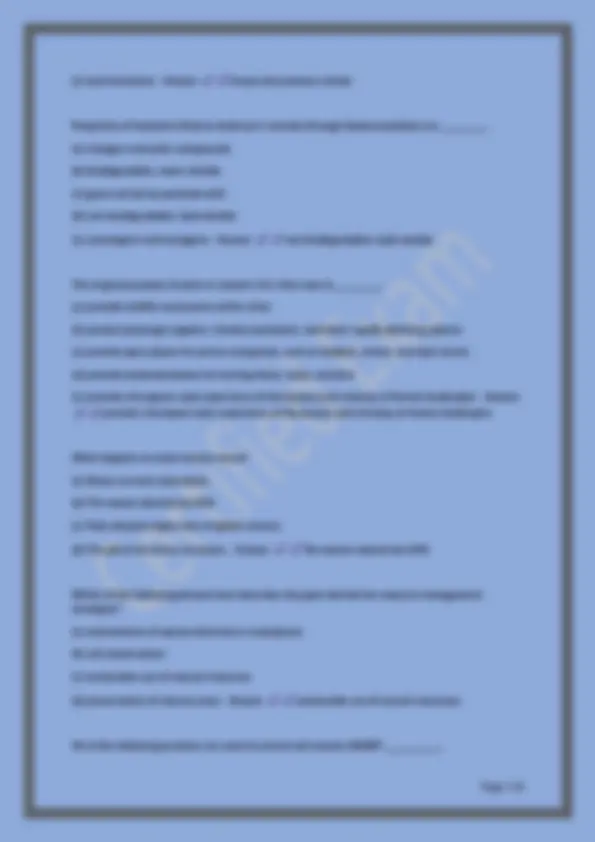
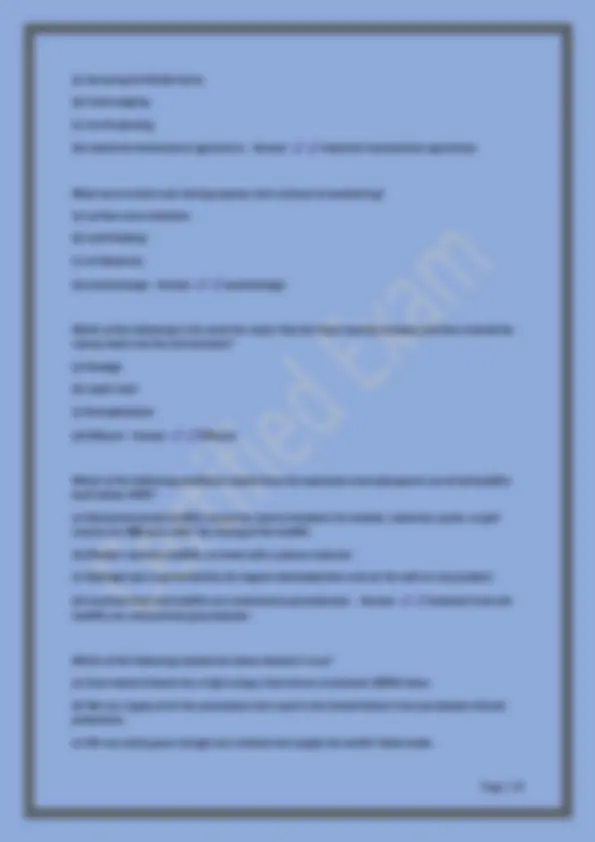
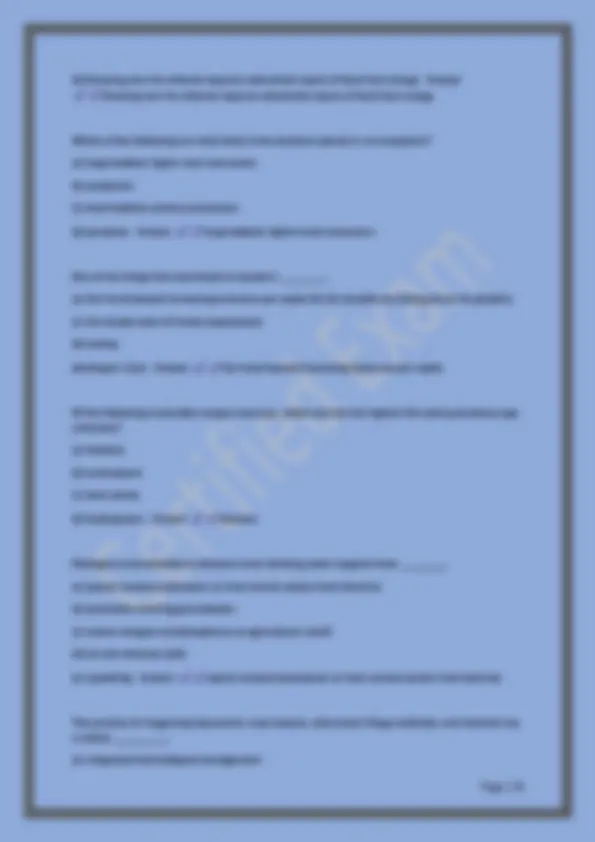
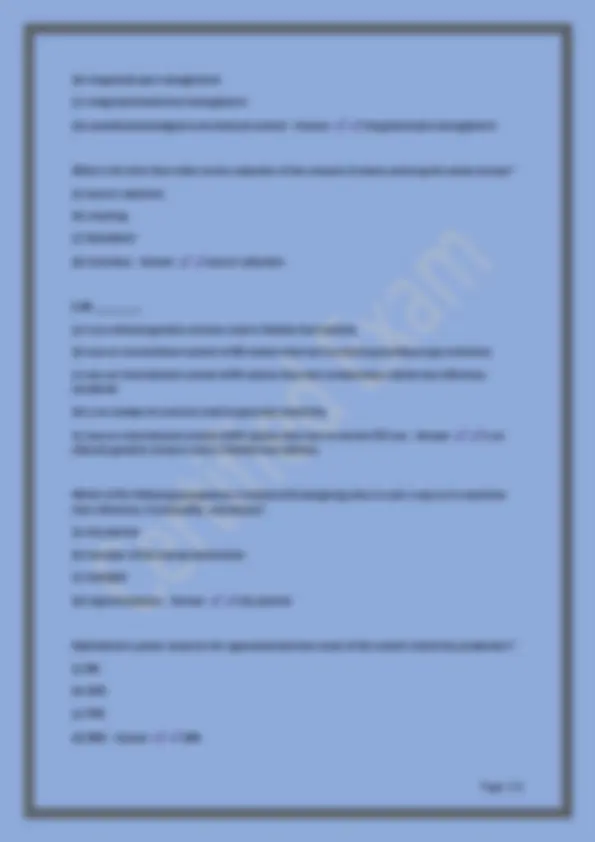
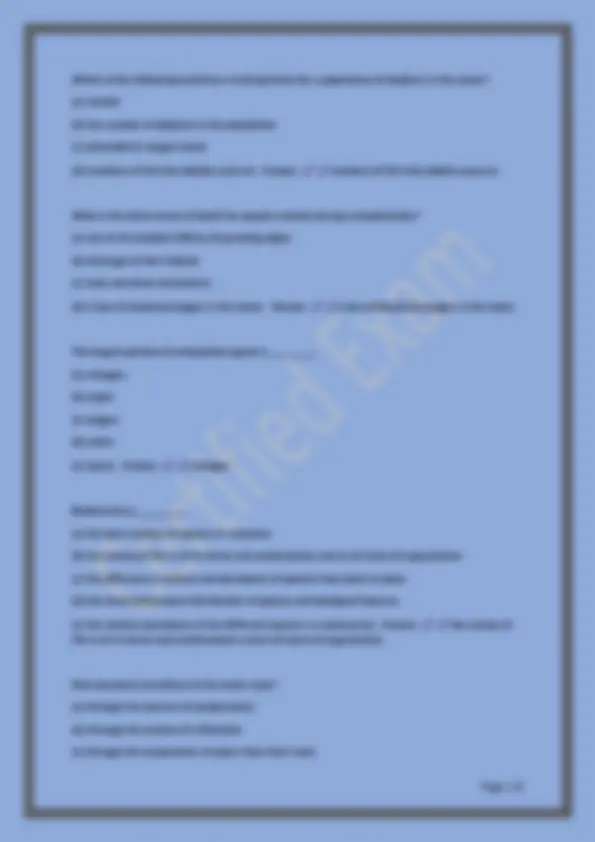
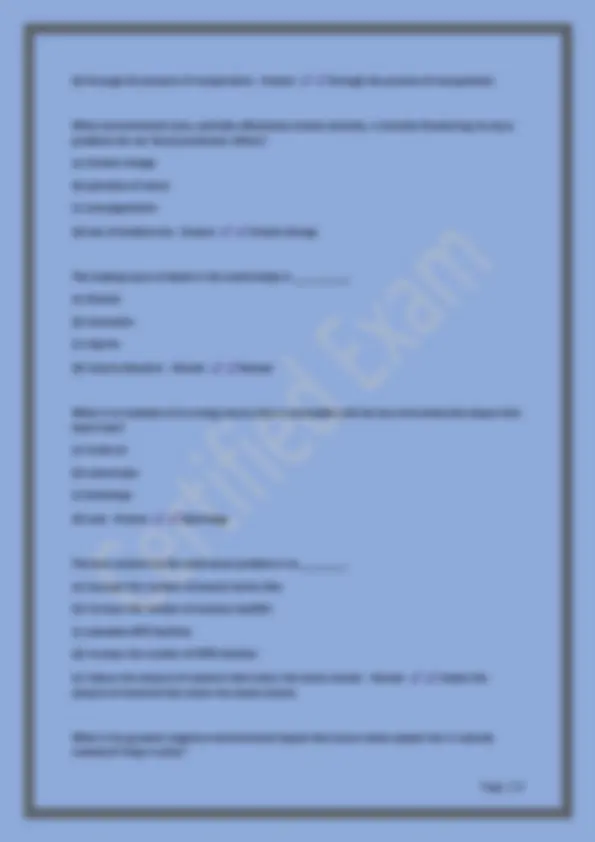
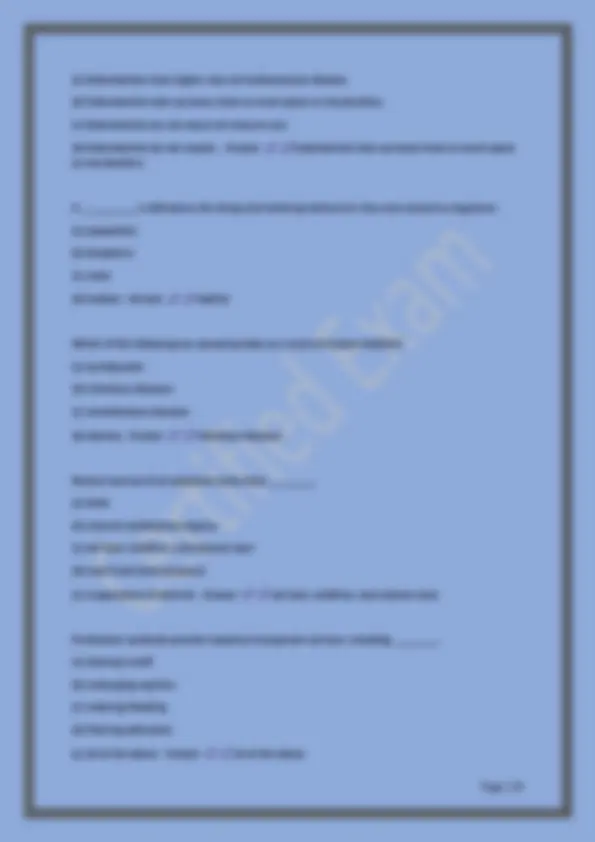
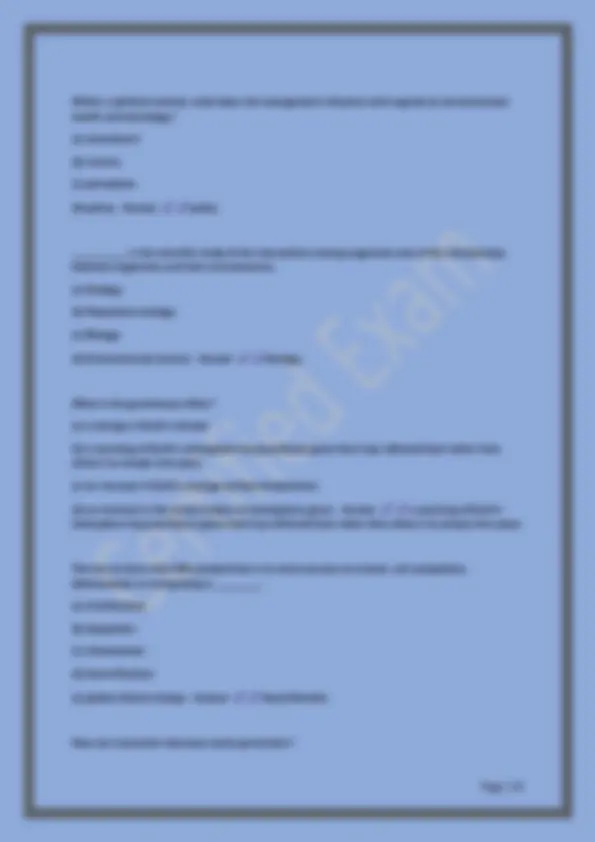
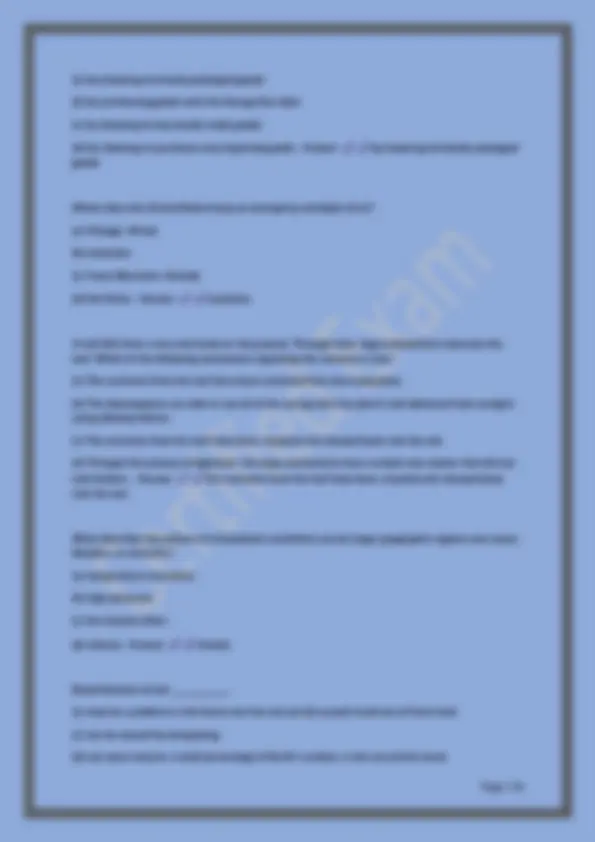
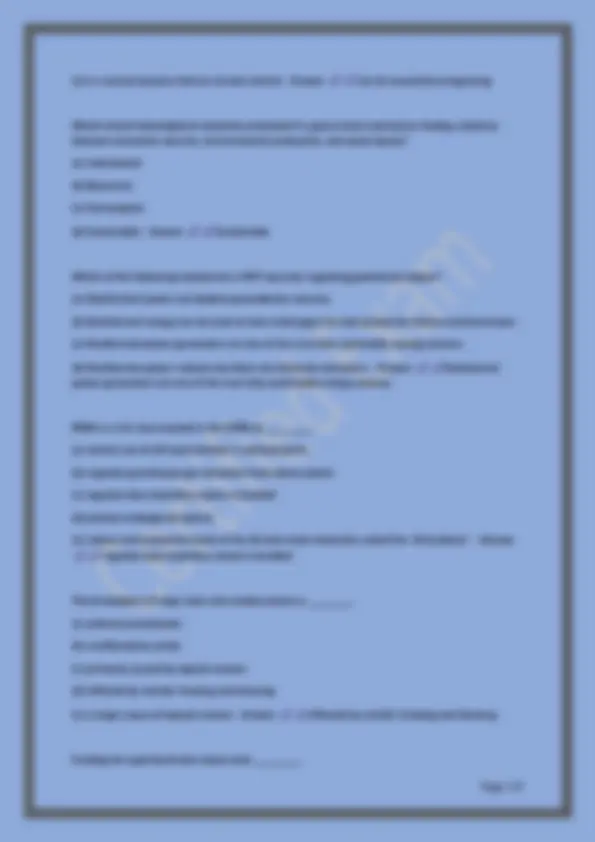
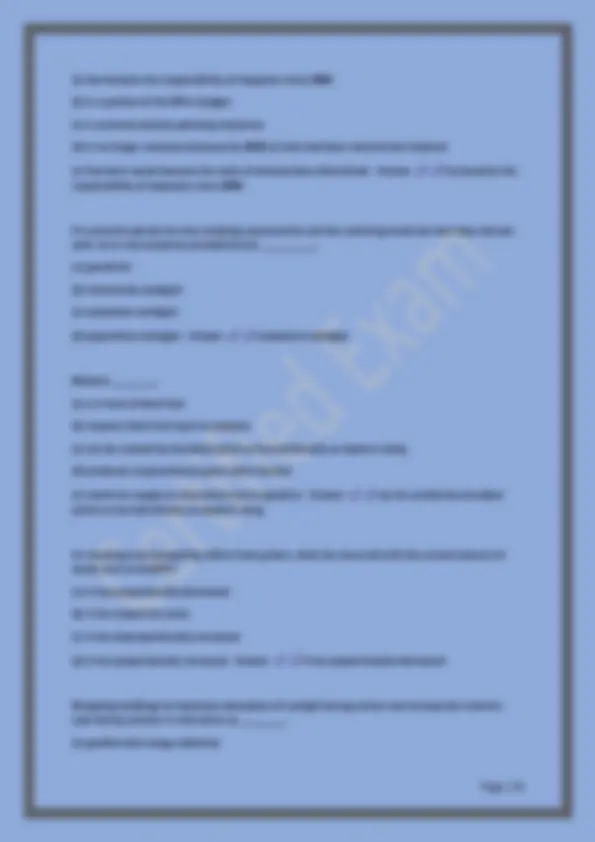
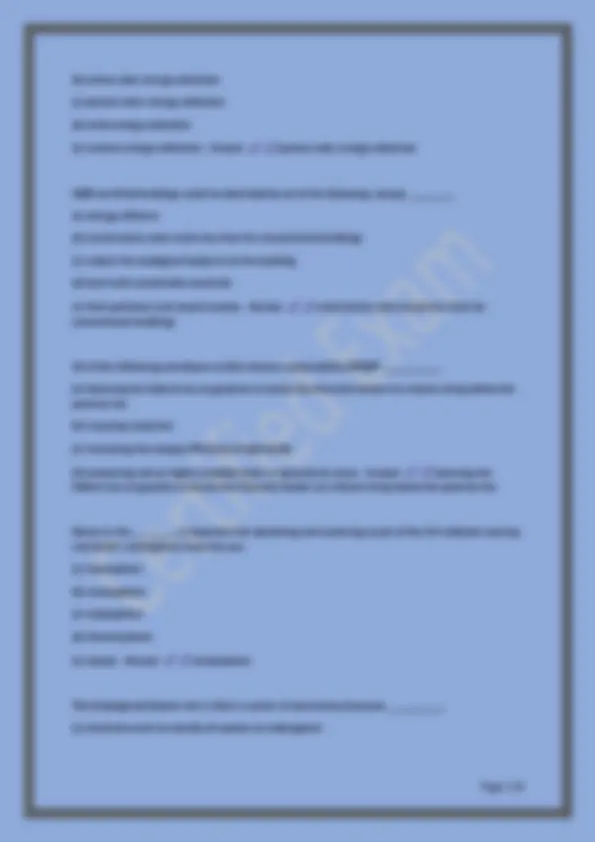
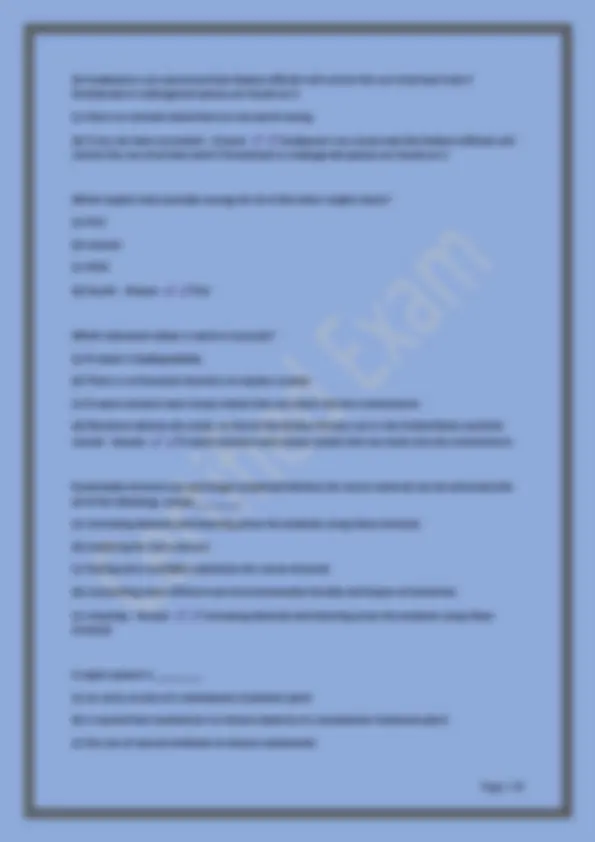
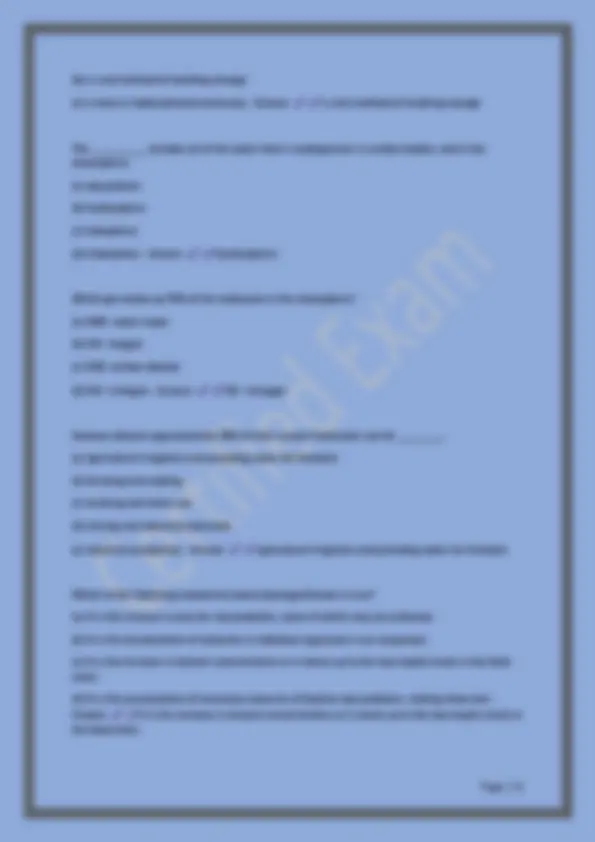
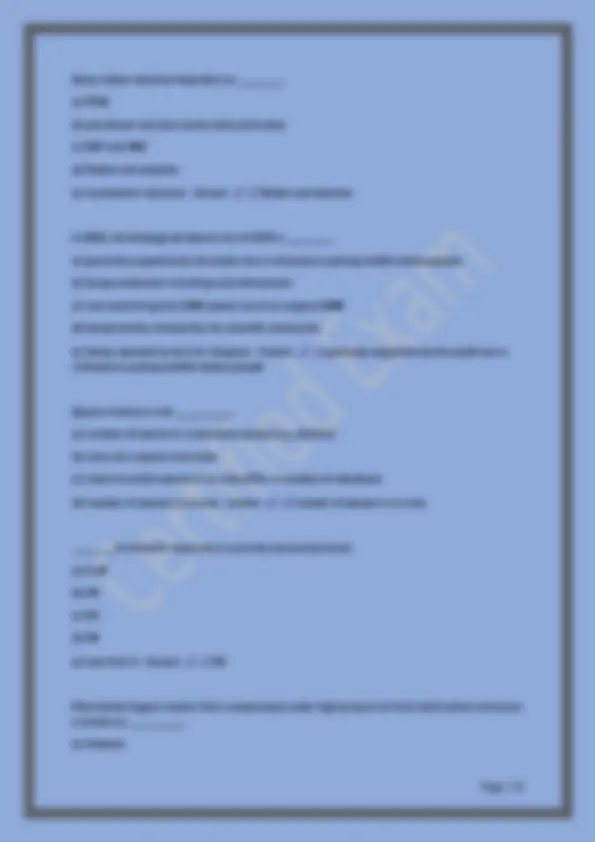
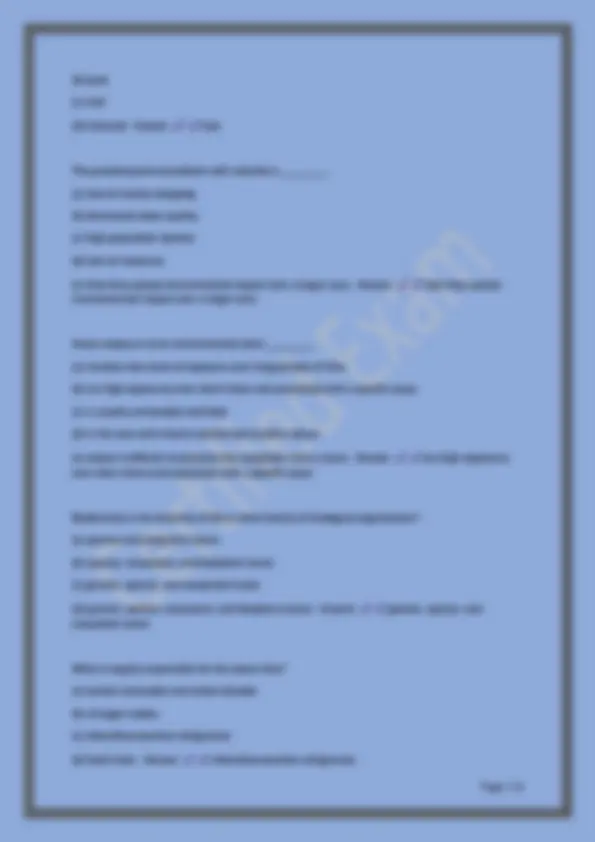
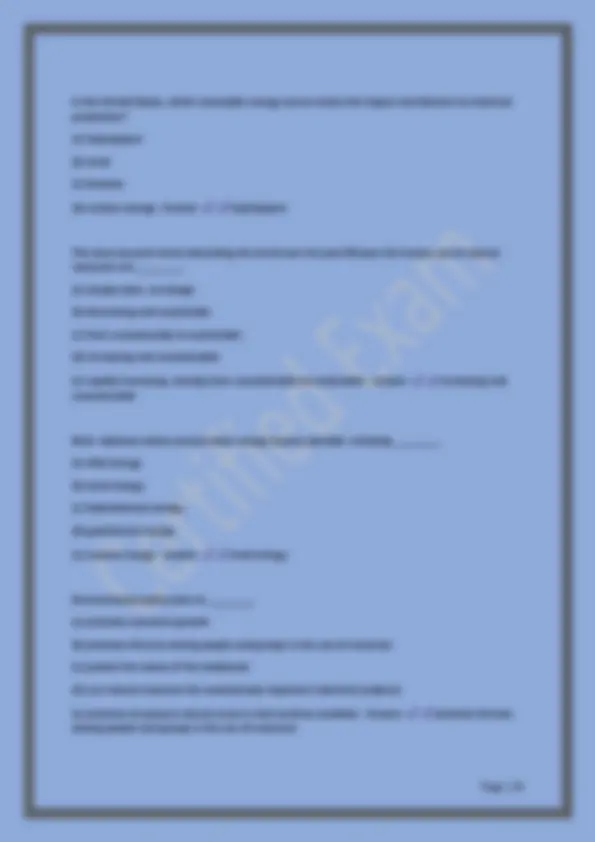
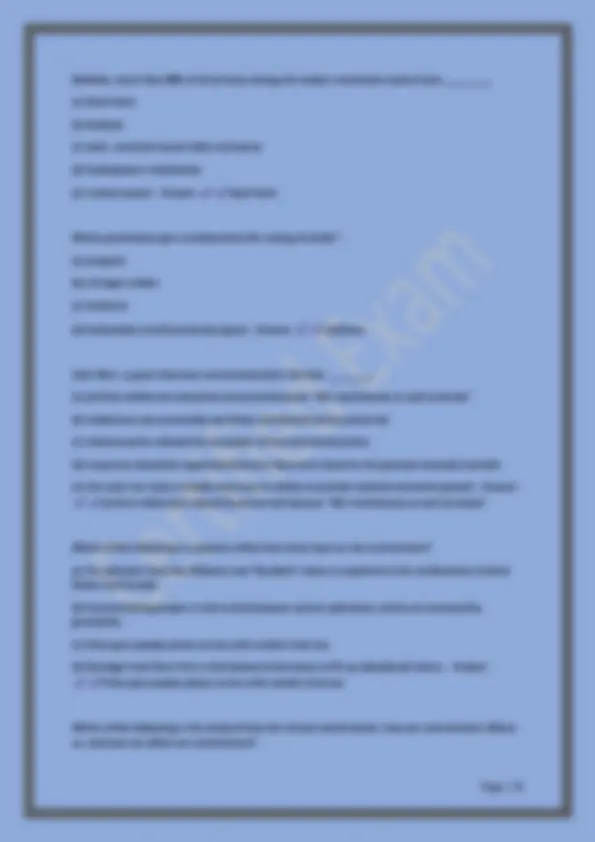
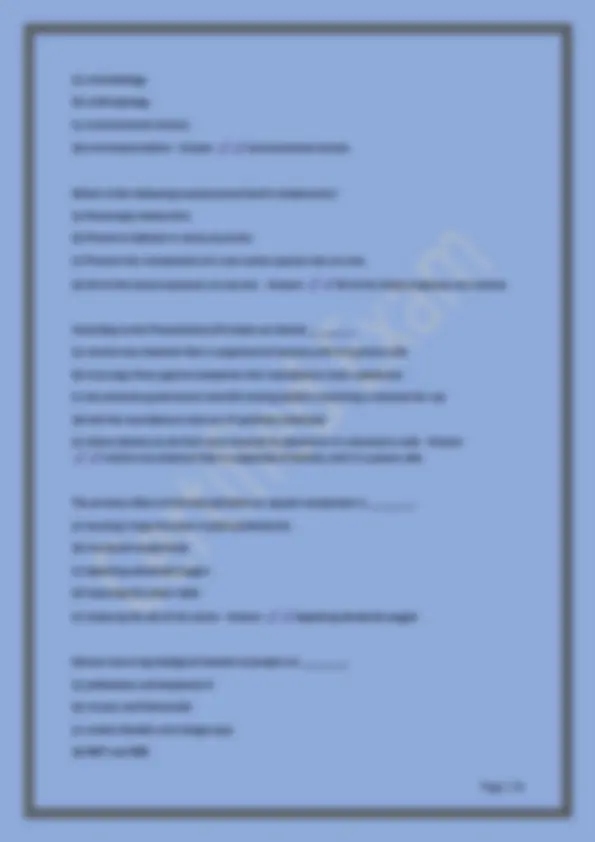
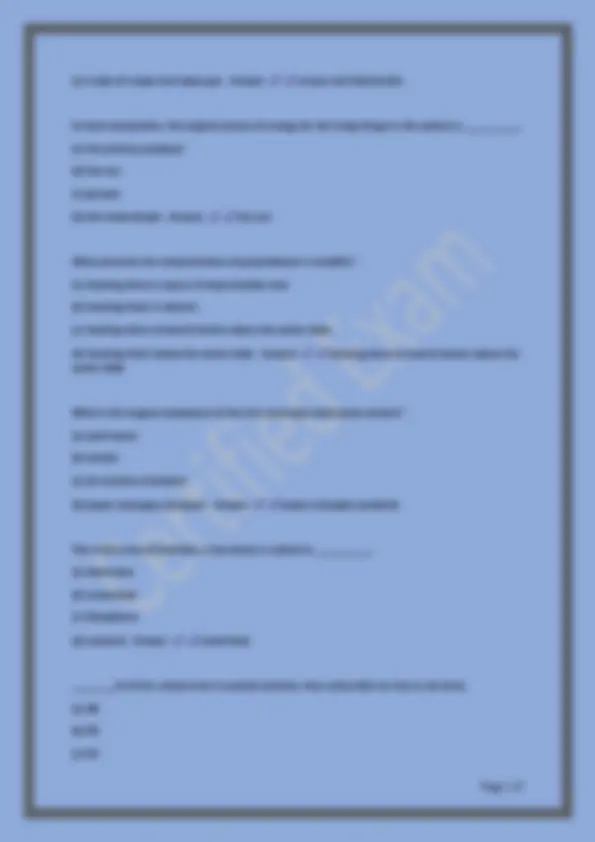
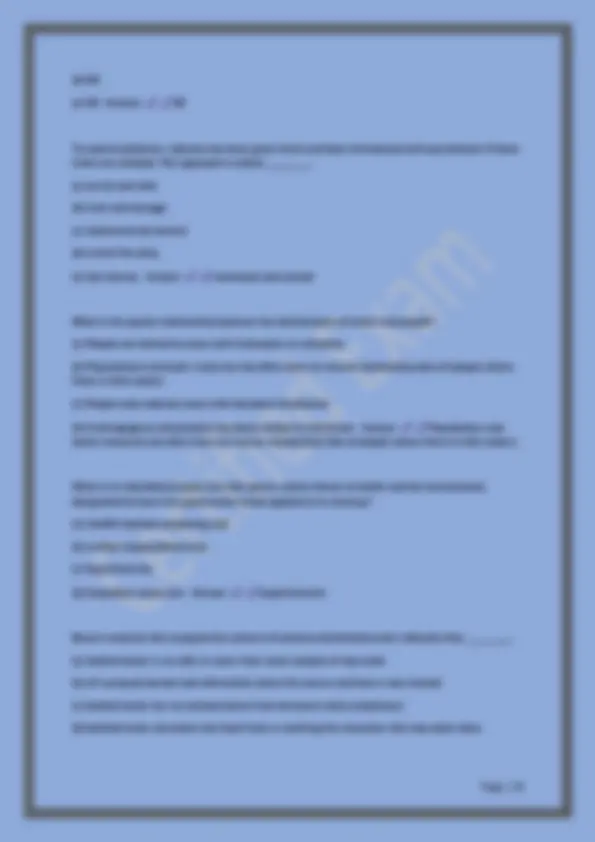
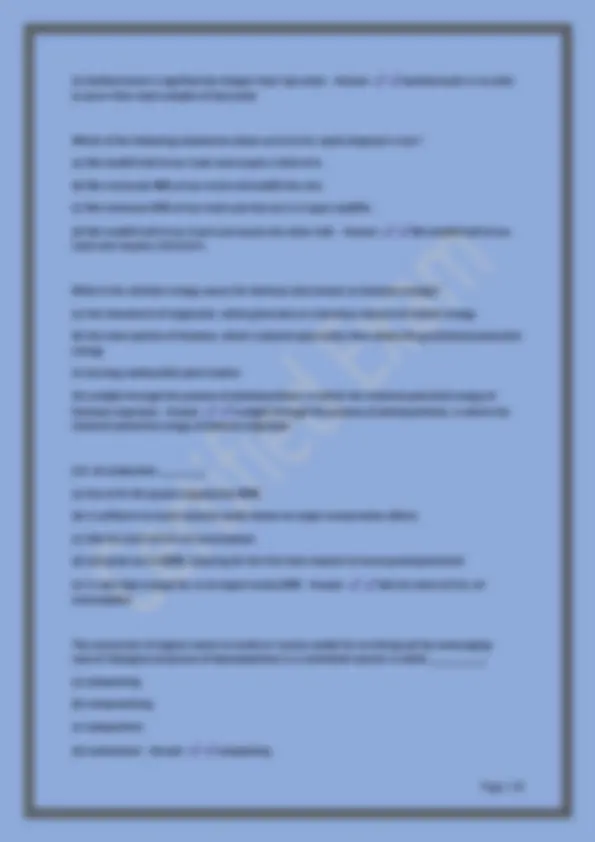
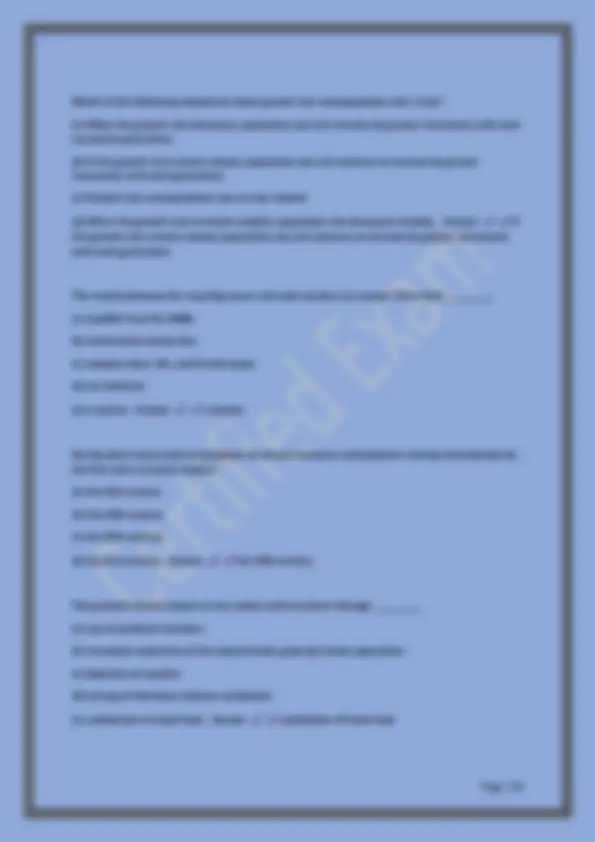
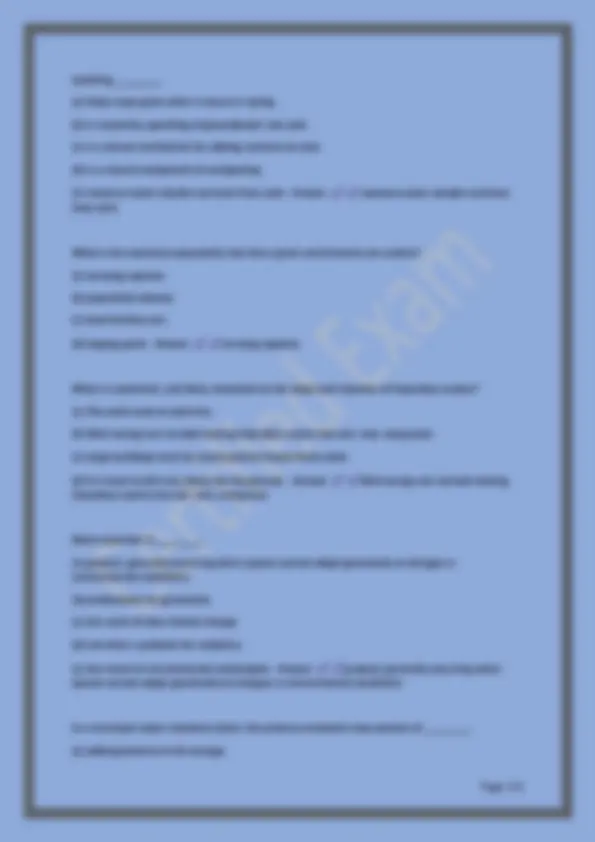
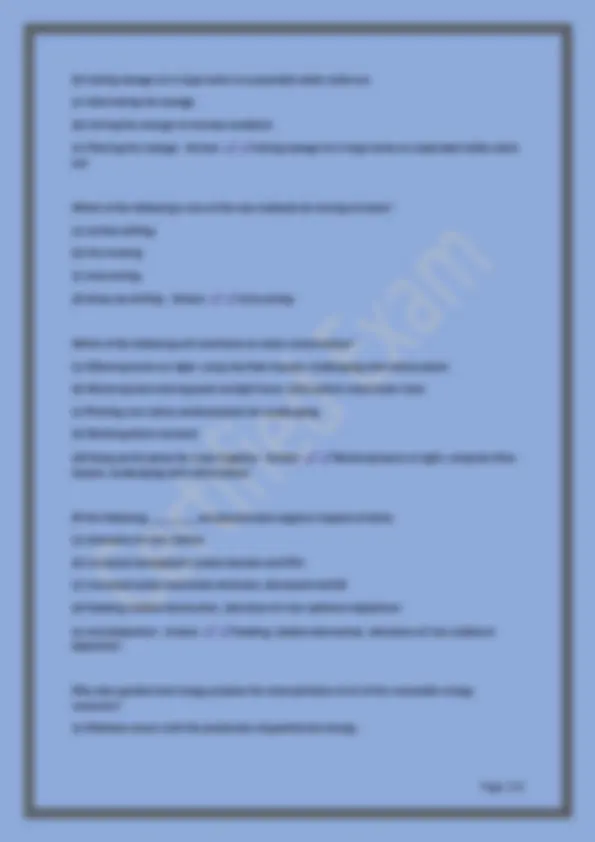
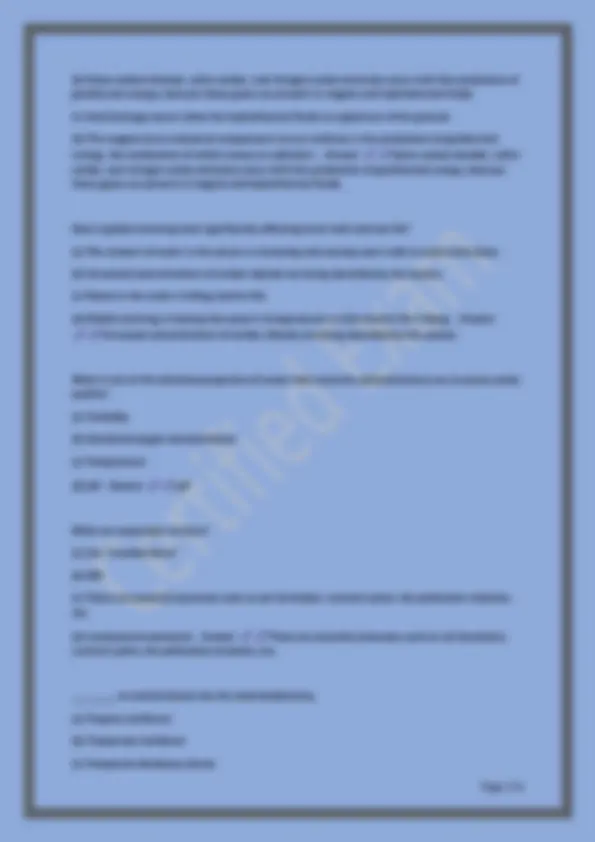
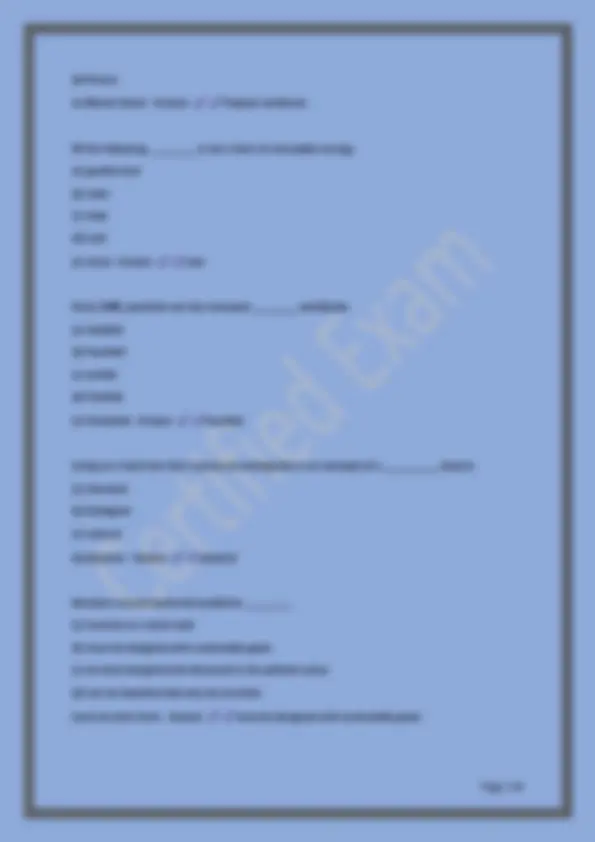
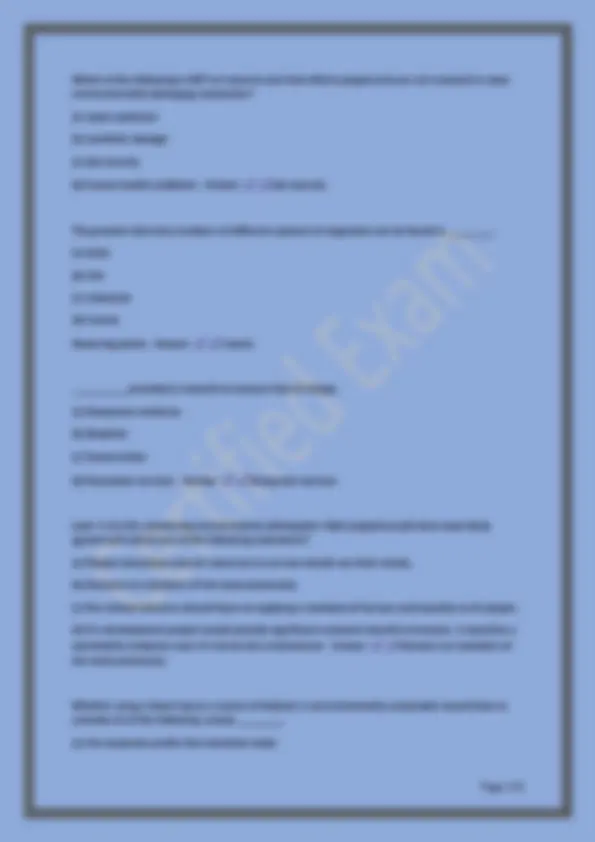
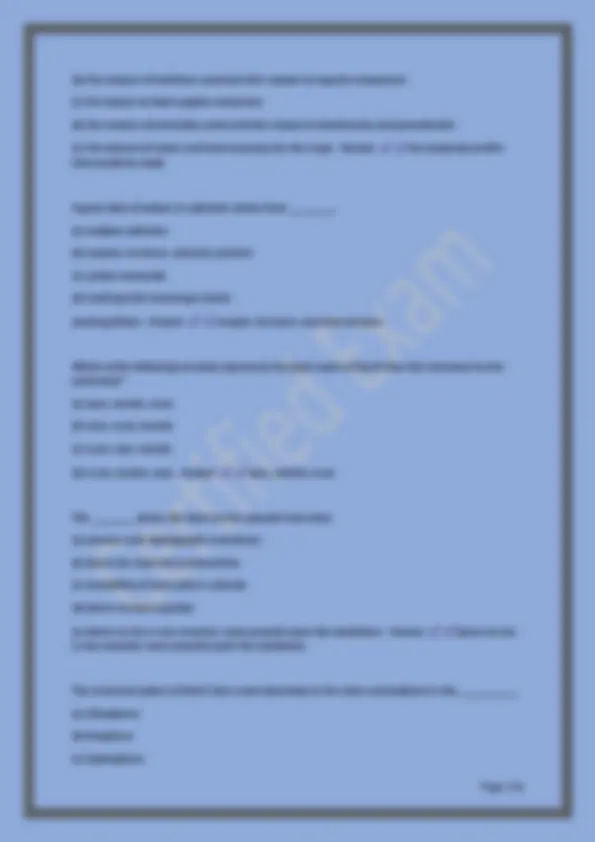
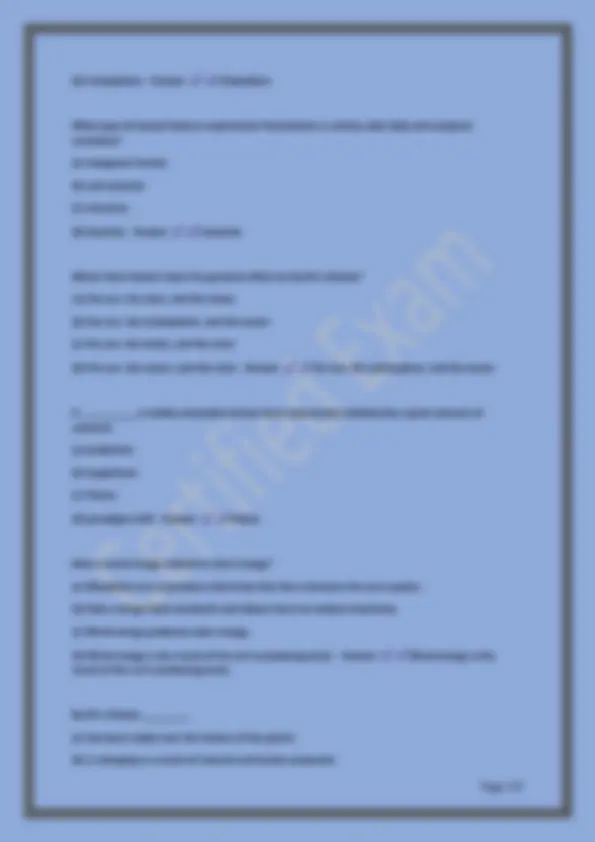
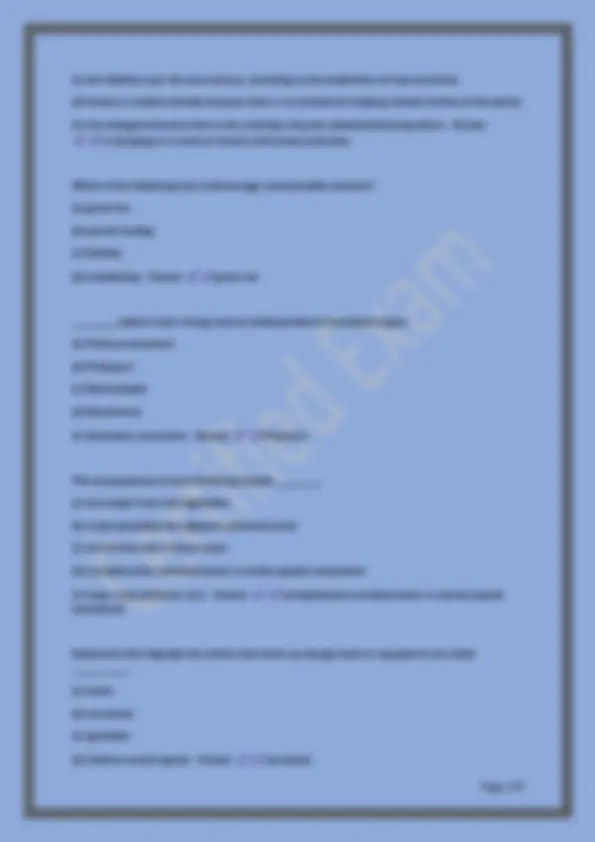
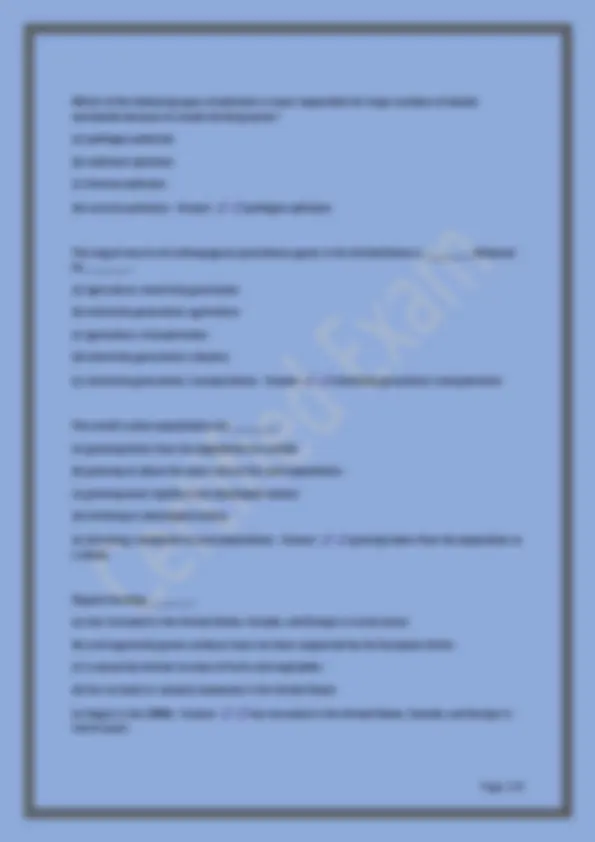
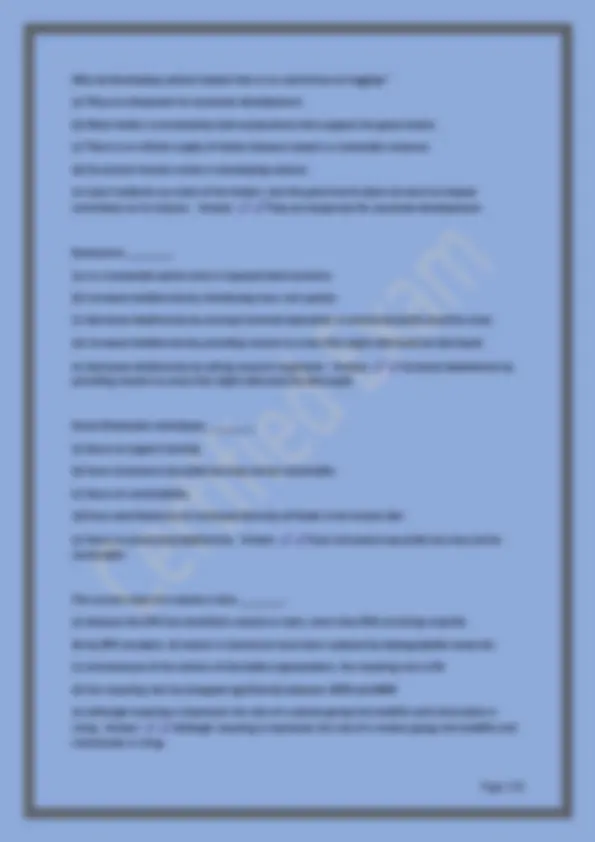
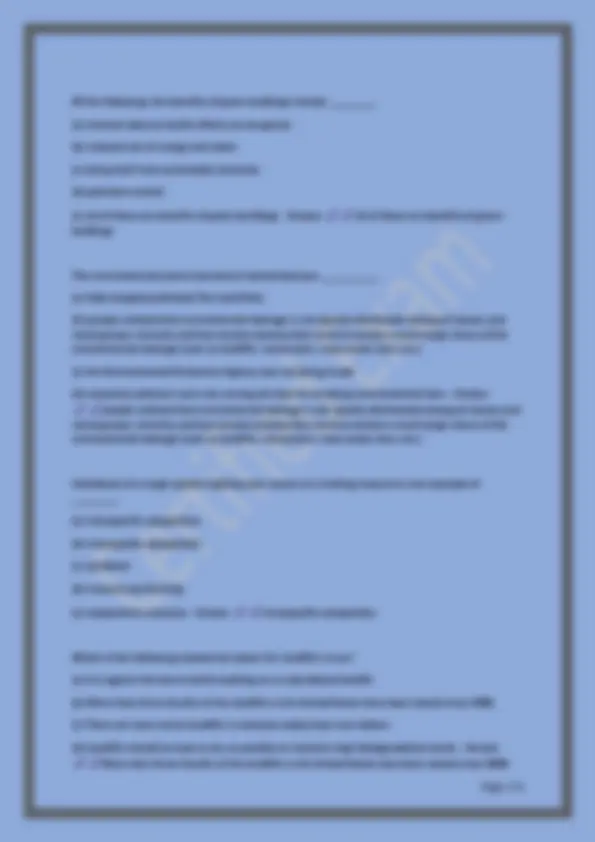
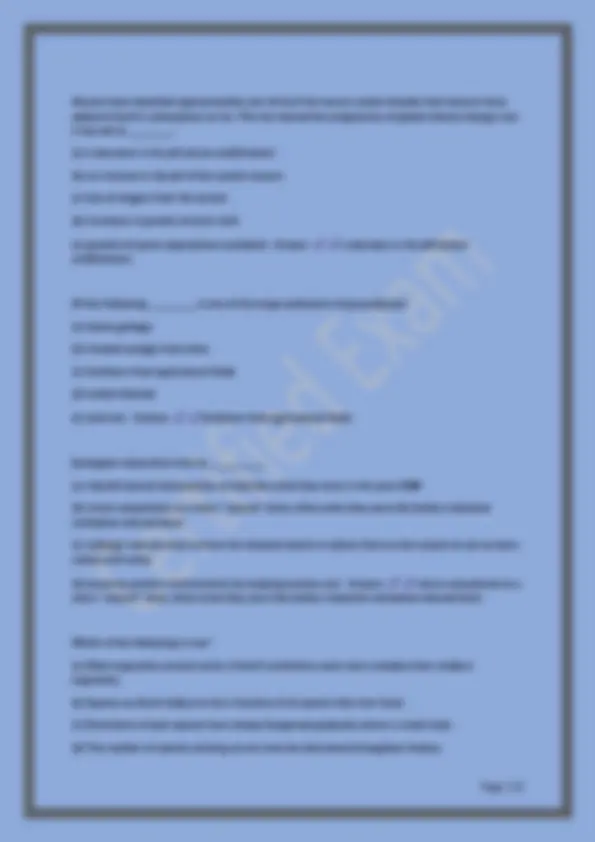
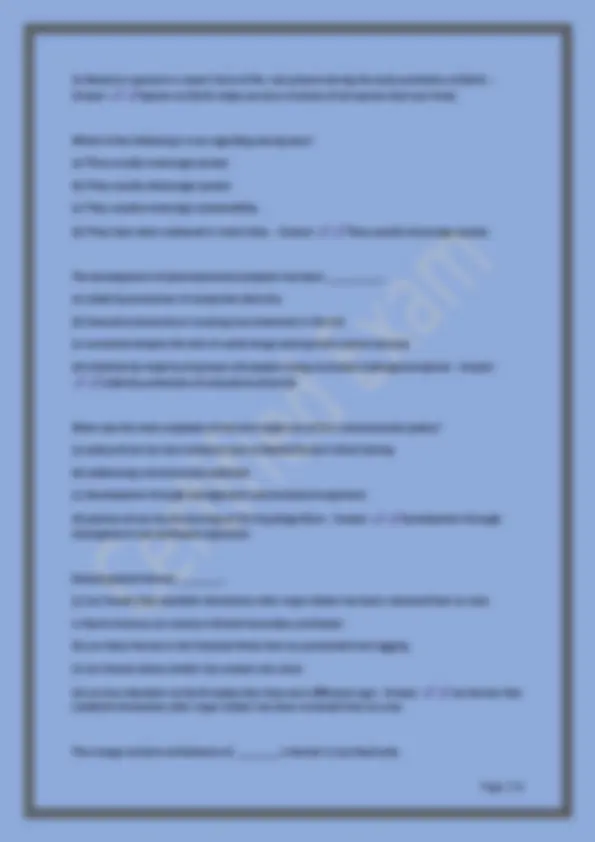
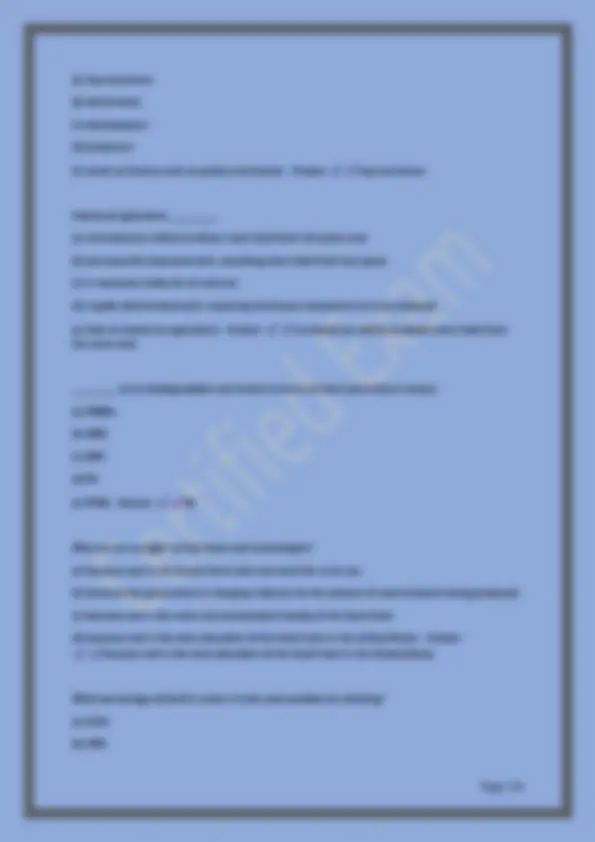
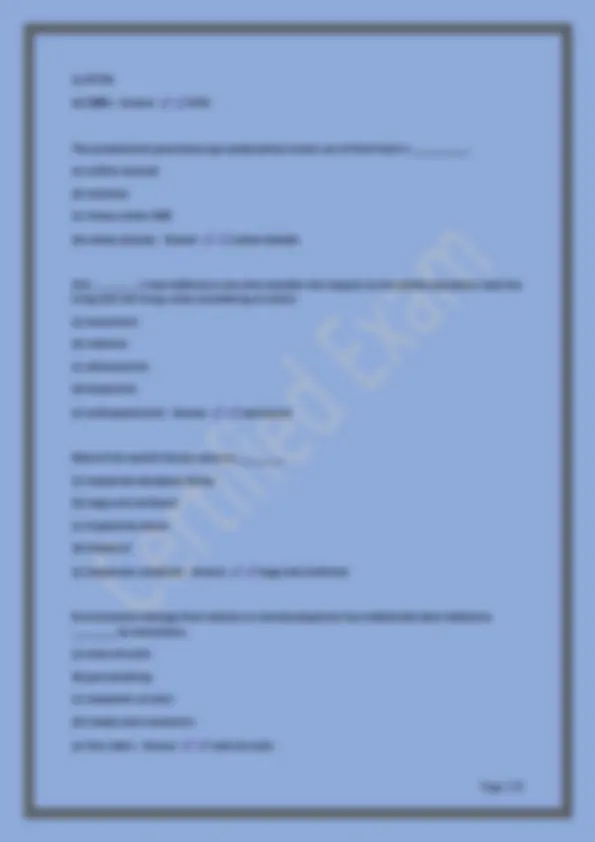
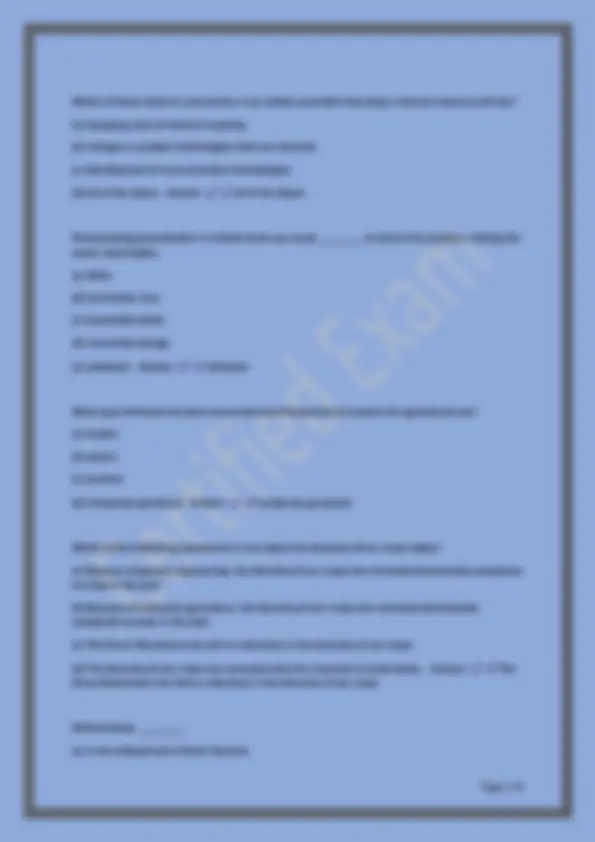
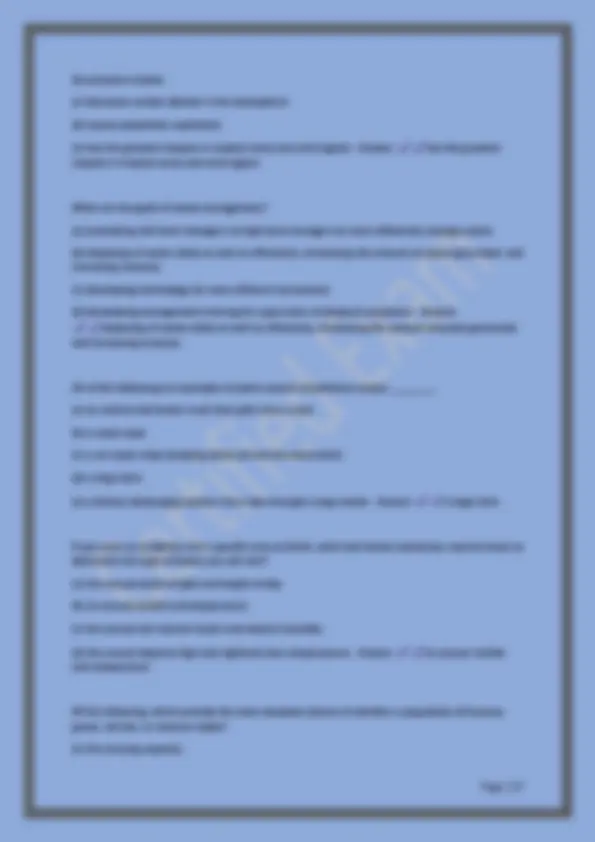
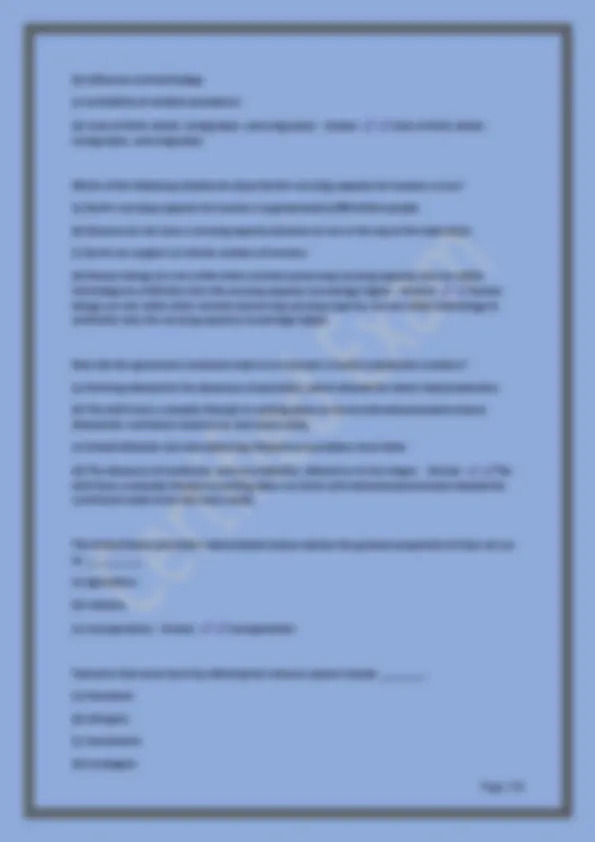
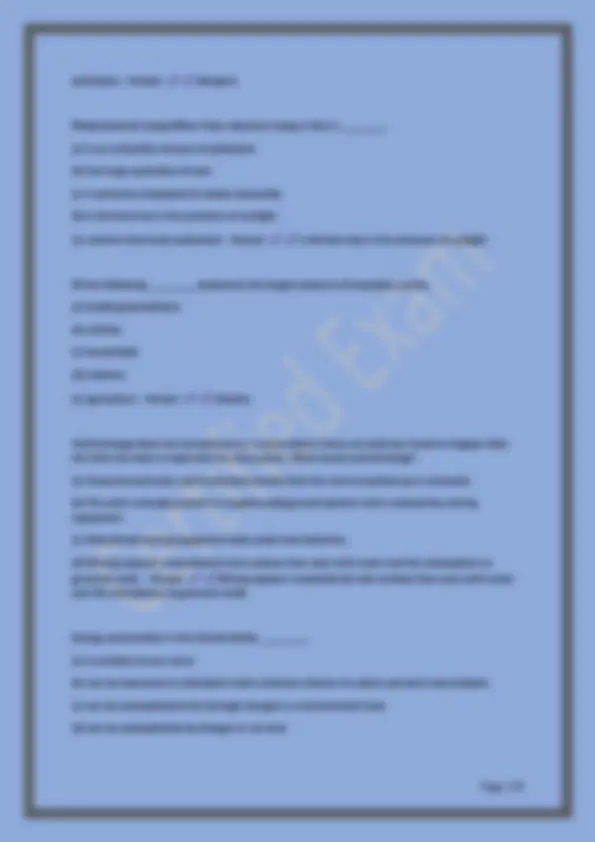
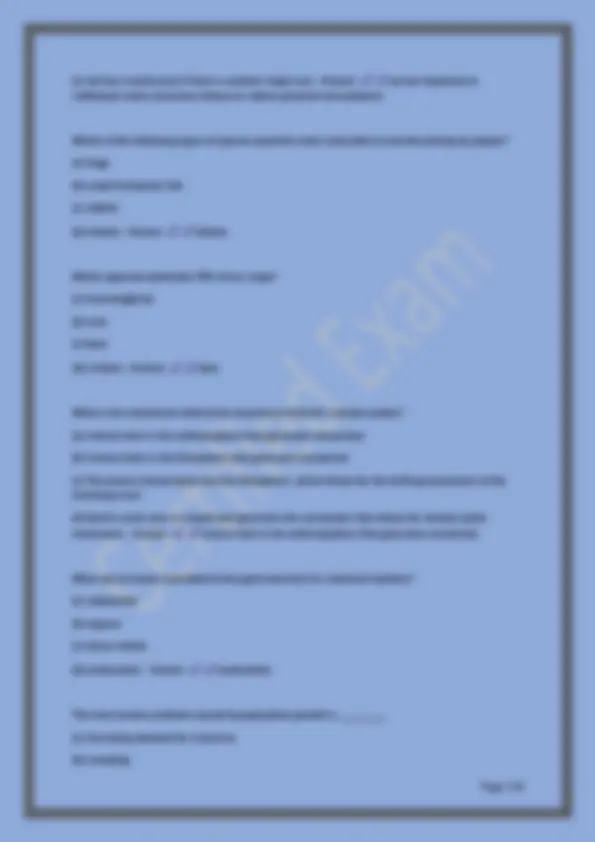
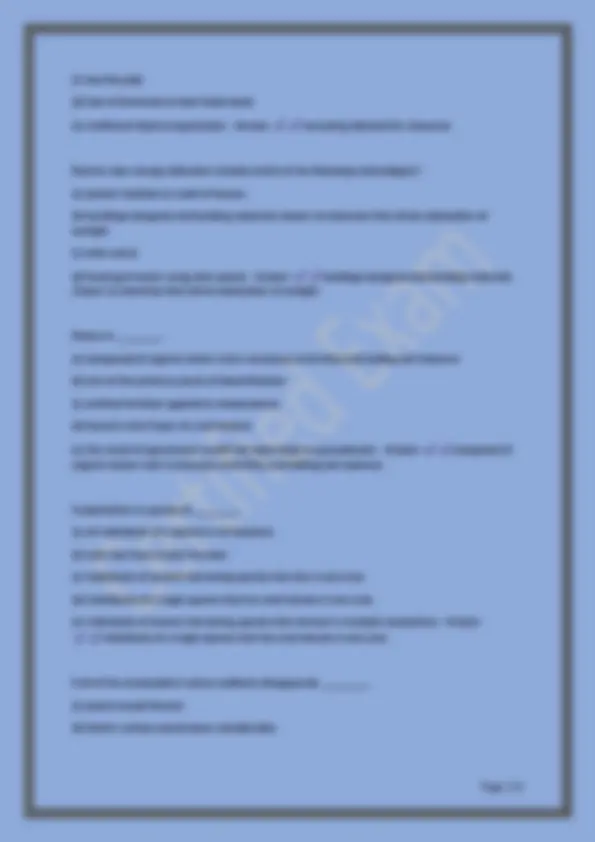
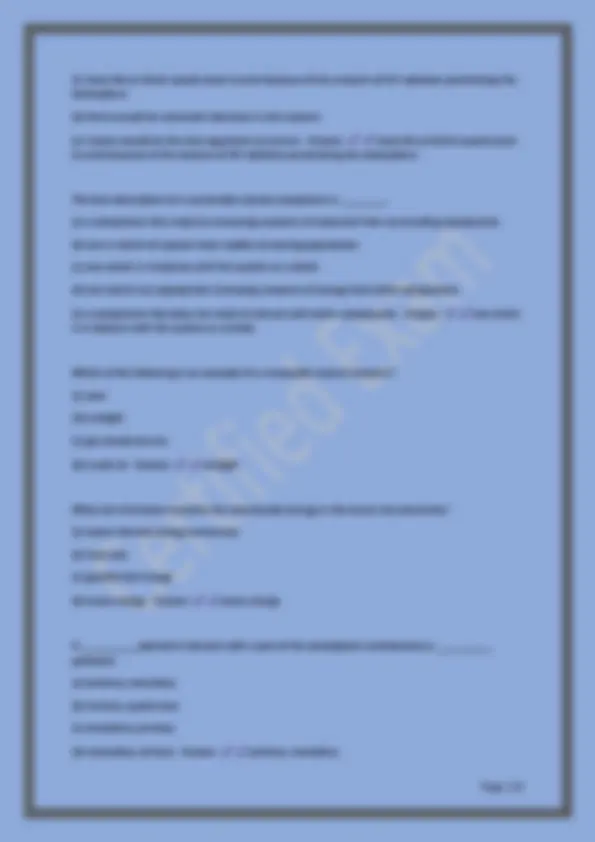
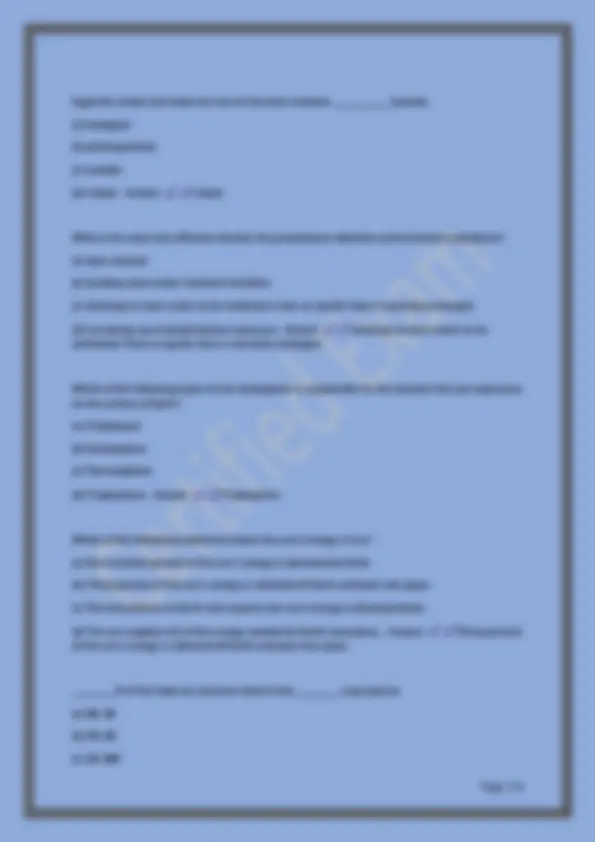
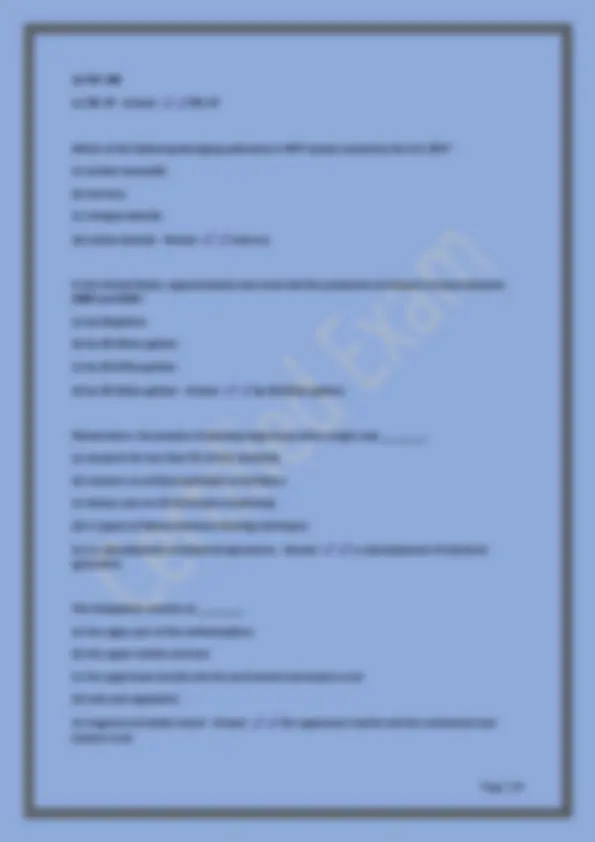
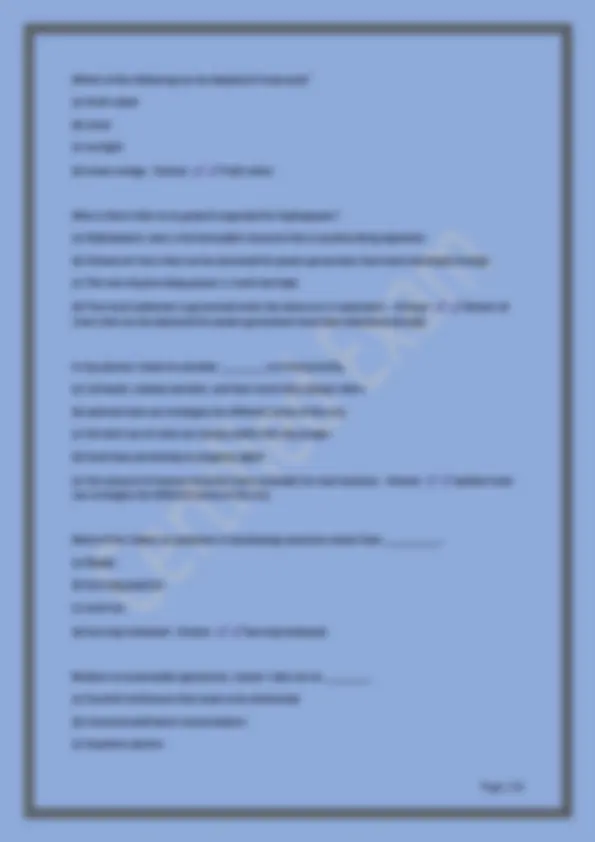
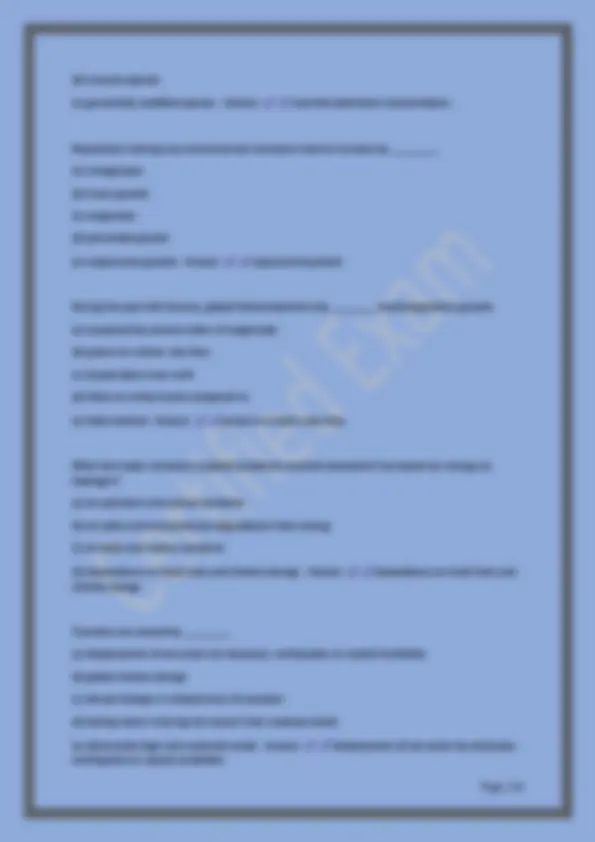
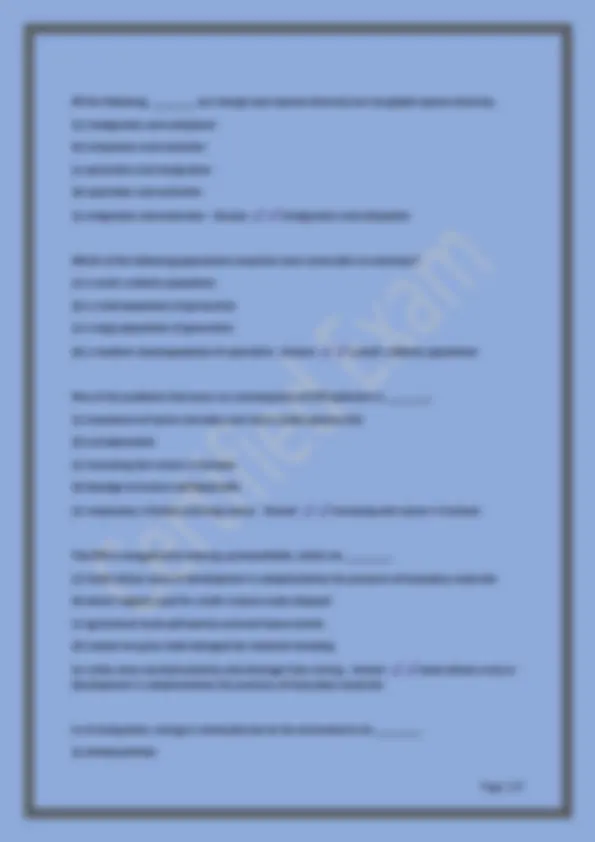
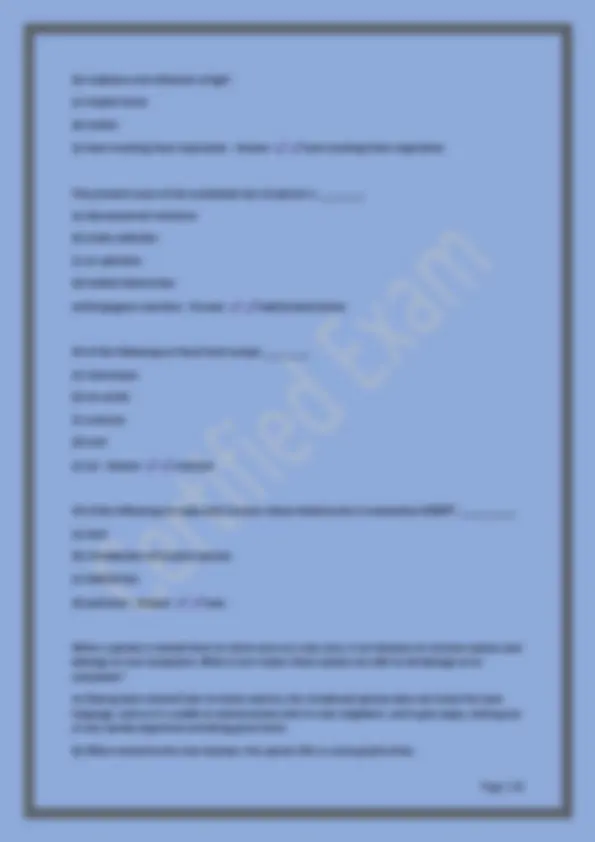
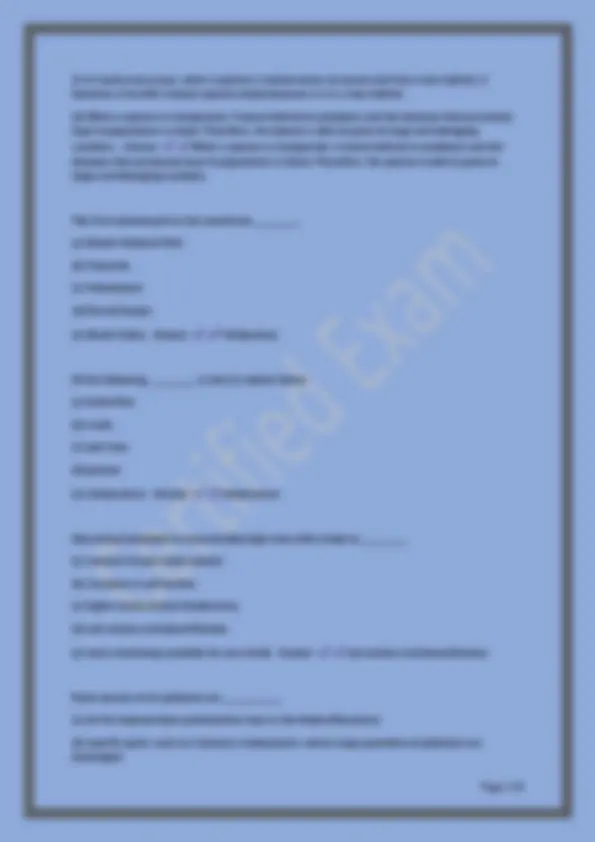
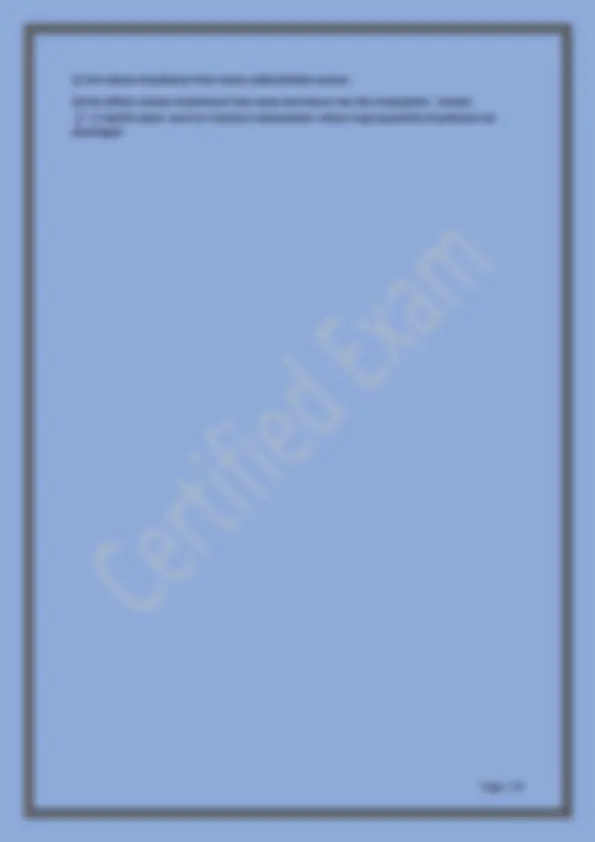


Study with the several resources on Docsity

Earn points by helping other students or get them with a premium plan


Prepare for your exams
Study with the several resources on Docsity

Earn points to download
Earn points by helping other students or get them with a premium plan
Community
Ask the community for help and clear up your study doubts
Discover the best universities in your country according to Docsity users
Free resources
Download our free guides on studying techniques, anxiety management strategies, and thesis advice from Docsity tutors
Environmental Science Final Exam Exam. Comprehensive Review (Chapters 1 18)18).
Typology: Exams
1 / 70

This page cannot be seen from the preview
Don't miss anything!































































What costs are associated with transactions that can result in damage to the environment, human health, and property? (a) internal costs (b) traditional market costs (c) external costs (d) tangential costs - Answer external costs Which of the following best describes the human population from early times to the present? (a) Slow, uneven growth until the 1800s, then increasingly rapid growth (b) Slow, steady growth throughout the period (c) Early rapid growth which has leveled off to a nearly constant rate in the last 20 years (d) Early rapid growth which has increased rapidly in the last 20 years (e) Rapid, explosive growth throughout the period - Answer Slow, uneven growth until the 1800s, then increasingly rapid growth Which lifestyle choice would cause the greatest reduction in greenhouse emissions? (a) using public transportation (b) driving a hybrid car (c) riding a bike (d) driving an electric car (plugged into the grid at night to be recharged) - Answer riding a bike What sort of far-reaching, even global, environmental impact can result from the eruption of especially large volcanoes? (a) the increased warming of the atmosphere due to heated particles in the air (b) the cooling of Earth's surface due to ash and emissions in the atmosphere, which block sunlight (c) warming Earth's oceans on a global scale
(d) widespread flooding due to the release of water vapor - Answer the cooling of Earth's surface due to ash and emissions in the atmosphere, which block sunlight A coyote, which can alter its food intake to match seasonal abundance of plants, fruits, or small animals, is considered to be ________. (a) a clumped species (b) a generalist, able to be flexible in major dimensions of its niche (c) an endemic, able to be flexible (d) a specialist, which has no niche (e) density-independent and resource neutral - Answer a generalist, able to be flexible in major dimensions of its niche An ecosystem ________. (a) is the total population of a specific kind of plant, animal or microbe and all members of which do or potentially can interbreed and produce young (b) is a collection of interacting species living in a specific area (c) encompasses all the organisms and the physical and chemical environment within an area (d) is a grouping of plants and animals that interacts with one another in a way that causes the grouping to die (e) is a regional grouping of plants, animals and other biotic factors - Answer encompasses all the organisms and the physical and chemical environment within an area Around the world, most major cities are situated ________. (a) on the more northern continents (b) at elevations above 500 m. (c) near mountains, usually in a valley (d) along rivers, oceans, roads, or train routes (e) in agricultural areas - Answer along rivers, oceans, roads, or train routes Many types of mining, such as for coal and copper, produce a specific type of water pollution called ________. (a) acid drainage (b) eutrophication
(e) is the EPA-approved method of disposing of low-level radioactive wastes - Answer injects mostly liquid hazardous wastes into porous rock isolated by impervious clay deep beneath human water supplies In regard to energy efficiency, aquaculture is __________. (a) approximately the same efficiency as harvesting fish from open waters (b) incredibly energy-inefficient compared to harvesting fish from open waters (c) incredibly energy-efficient compared to harvesting fish from open waters (d) approximately the same efficiency as harvesting bycatch - Answer incredibly energy- efficient compared to harvesting fish from open waters The carrying capacity is __________. (a) the greatest number of niches possible in a given area (b) the potential number of species that could exist in a given area (c) the maximum population size that a given environment can sustain (d) always the same for a given habitat - Answer the maximum population size that a given environment can sustain Which of the following is one of the three current major drawbacks of solar energy? (a) Certain greenhouse gases are emitted with its use. (b) This resource is intermittent in nature. (c) The resource is nonrenewable. (d) It emits radiation. - Answer This resource is intermittent in nature The ecological footprint of a large city is ________ than/as the surrounding rural area. (a) much lower (b) much higher (c) slightly higher (d) slightly lower (e) about the same size - Answer much higher Which of the following is an example of the single greatest cause of species extinction?
(a) habitat fragmentation caused by building a road through a forest (b) overfishing of ocean fish (c) heavy metal runoff from a manufacturing plant (d) introducing rats, cats, and snakes to islands - Answer habitat fragmentation caused by building a road through a forest Of the following energy sources, ________ is considered nonrenewable. (a) sunlight (solar) energy (b) tidal energy (c) geothermal energy (d) wind energy (e) fossil fuel energy - Answer fossil fuel energy Electronic waste, or e-waste, consists of discarded cell phones, computers, and other electronic products and is increasing rapidly. Recycling e-waste is essential because ________. (a) recycling helps reduce the amounts of hazardous substances in landfills, because e-wastes contain a number of these substances (b) recycling conserves valuable metals present in e-waste, such as copper, gold, tantalum, and iridium (c) recycling of e-waste reduces the need to extract new deposits of metals and other components (d) recycling of e-wastes at present only captures a small fraction of the e-waste produced (e) all of the above are correct - Answer all of the above are correct How do toxicants get transported over vast distances? (a) Animals deliberately carry toxicants with them across Earth. (b) Toxicants are carried by the wind as well as the waters of streams and the oceans. (c) Human beings carry toxicants on their skin, which become released into the water when they bathe. (d) Toxicants are transmitted through electromagnetic waves within Earth, the oceans, and the air.
Which of the following harvesting methods is the most cost-efficient but has the greatest ecological impacts? (a) the shelterwood approach (b) clear-cutting (c) the seed-tree approach (d) the uneven approach - Answer clear-cutting Which of these is a major reason that we have used fossil fuels rather than their alternatives? (a) Our supplies of fossil fuels are limited, and in most cases we may have only a few decades' supply remaining. (b) Fossil fuels produce more air pollution. (c) Market costs are generally lower for fossil fuels than for their alternatives. (d) Fossil fuels add carbon dioxide to the global carbon cycle, increasing greenhouse gases and contributing to global climate change. - Answer Market costs are generally lower for fossil fuels than for their alternatives. Scientists currently assessing the environmental impacts of the 2010 Deepwater Horizon oil spill in the Gulf of Mexico report that ________. (a) it may take years or decades before the full impacts are known (b) the entire Gulf food web will eventually collapse (c) the damage was limited to wildlife kills immediately after the spill (d) the coastal marshes of Louisiana suffered no measurable damage (e) Gulf productivity has already returned to normal and no further effects will be felt - Answer it may take years or decades before the full impacts are known What is the process in which forest plants release water back into the atmosphere? (a) snag (b) clear-cutting (c) deforestation (d) transpiration - Answer transpiration Which of the following soil horizons is most severely affected by erosion? (a) A
(b) B (c) C (d) R - Answer A Removal of ________ will always result in the greatest changes in an ecological system.a decomposer species (a) a carnivore species (b) a competitive species (c) a keystone species (d) a producer species - Answer a keystone species Of the following, ________ represent proper ranking of the U.S. total primary energy consumed from the greatest to least used. (a) fossil fuels, bioenergy, hydroelectric, nuclear, new renewables (b) fossil fuels, bioenergy, nuclear, hydroelectric, new renewables (C) fossil fuels, bioenergy, hydroelectric, new renewables, nuclear (d) bioenergy, fossil fuels, nuclear, hydroelectric, new renewables (e) fossil fuels, nuclear, bioenergy, hydroelectric, new renewables - Answer fossil fuels, nuclear, bioenergy, hydroelectric, new renewables Aquatic animals such as fish and frogs are especially good indicators of water pollution because ________. (a) all chemical toxicants are found in water (b) they are easy to catch (c) most chemicals are water soluble so they enter these organisms through drinking or skin absorption (d) these organisms are the most abundant on Earth (e) the metabolism of these organisms is most like ours - Answer most chemicals are water soluble so they enter these organisms through drinking or skin absorption ________ represent(s) the largest source of unregulated hazardous waste. (a) Farmers (b) Utilities
(c) most of this is in underground aquifers (d) most of this is in large, freshwater lakes (e) over half of this is in wetlands near coastlines and is becoming contaminated with saltwater - Answer most of this is in polar ice caps, glaciers, and underground aquifers and is not easily accessed for human use What are green buildings? (a) inexpensively constructed buildings that help save taxpayers a lot of money (b) buildings covered in vines and plant life that enable energy-efficient cooling and heating as well as providing food (c) buildings constructed out of sustainable materials, which limit the use of energy and water, minimize health impacts, control pollution, and recycle waste (d) buildings painted green to help reflect sunlight - Answer buildings constructed out of sustainable materials, which limit the use of energy and water, minimize health impacts, control pollution, and recycle waste Which of the following is a consequence of acidic deposition? (a) It creates rainwater that can damage skin cells or cause cancers. (b) It is increasing the rate of global warming. (c) It increases the likelihood of low-lying ground fogs. (d) It results in offshore eutrophication, damaging coral reefs. (e) It leaches out important minerals from soils and causes a loss of biodiversity. - Answer It leaches out important minerals from soils and causes a loss of biodiversity. Why is variety in crop plants important for "food security"? (a) Monocultures are not capable of reproducing. (b) People and the food industry naturally want a wide variety of different types of food plants. (c) Varieties contain genes that, through conventional breeding, might confer resistance to disease. (d) Monocultures are inherently stable. - Answer Varieties contain genes that, through conventional breeding, might confer resistance to disease. Growing rice results in the release of ________ into the atmosphere. (a) ozone
(b) sulfate aerosols (c) methane (d) sulfur oxides (e) carbon dioxide - Answer methane What is one problem associated with the incineration of solid waste? (a) hazardous chemicals are often created and released into the atmosphere (b) the volume of waste increases (c) the waste is radioactive (d) leachate the may contaminate groundwater - Answer hazardous chemicals are often created and released into the atmosphere Biodiversity enhances human food security because it ________. (a) reduces the number of pollinators available to any one plant species (b) increases the number of available pathogens (c) decreases the number of predators (d) means that there is genetic uniformity (e) is a potential source of new food items or new genetic varieties of existing foods - Answer is a potential source of new food items or new genetic varieties of existing foods What is the status of GM products in the United States? (a) U.S. citizens have largely accepted the GM crops on the market. (b) GM crops can be sold in the United States only if they are labeled as being genetically modified. (c) GM crops have been banned in the United States. (d) GM crops will only be sold in the United States for livestock feed. - Answer U.S. citizens have largely accepted the GM crops on the market Which of the following statements about ocean water is true? (a) Oceans change temperature more quickly than the land changes temperature. (b) Surface waters change temperature more slowly than oceans. (c) Oceans have a high heat capacity and change temperature slowly.
(a) a pollutant emitted into the troposphere in a form that is directly harmful (b) a pollutant that develops after a chemical reaction with chemicals normally present in the atmosphere (c) a minor pollutant released by a factory - Answer a pollutant that develops after a chemical reaction with chemicals normally present in the atmosphere The Mid-Atlantic Ridge is a divergent boundary that bisects the entire Atlantic Ocean. What is produced at this and other mid-ocean ridges? (a) new oceanic crust (b) water (c) oil (d) coal - Answer new oceanic crust Water bodies where rivers flow into the oceans, mixing fresh water with saltwater, are called ________. (a) upwellings (b) salt marshes (c) mangroves (d) estuaries (e) littoral ecosystems - Answer estuaries All of the following are advantages of nuclear power except ________. (a) uranium generates far greater amounts of energy than coal by weight or volume (b) uranium mines cause less environmental damage than coal mines because less uranium is needed to generate power (c) the power-generating process is emission-free (d) nuclear power plants generate no nitrogen oxides and sulfur dioxide (e) safe disposal of nuclear waste - Answer safe disposal of nuclear wastes Which of the following is the broadest (most all-encompassing) level of ecological organization? (a) a population (b) the biosphere
(c) an ecosystem (d) a kingdom - Answer the biosphere What is the goal of "new urbanism"? (a) to create functional neighborhoods in which most of a family's needs can be met close to home without the use of a car (b) to shift transportation planning away from SUV-sized vehicles to accommodate hybrid cars (c) to provide modern urban attractions (high-speed Internet, cultural institutions, and so on) to rural areas so people will return to a rural lifestyle (d) to improve quality of life by separating residential areas from all other types of development - Answer to create functional neighborhoods in which most of a family's needs can be met close to home without the use of a car Weather patterns are largely determined in the ________. (a) troposphere (b) lithosphere (c) stratosphere (d) biosphere (e) mesosphere - Answer troposphere The initial consequence of falling water tables would be the loss of ________. (a) agricultural irrigation water (b) mammals that thrive in dry habitats (c) deep lakes (d) trees that do best with low precipitation (e) birds that live in upland areas - Answer agricultural irrigation water Which of the following best describes an umbrella species? (a) a particularly showy species that people will want to protect because it is so attractive (b) a species that, if removed, will cause the community to collapse and be reduced in its biodiversity (c) a species whose protection will result in the protection of a large number of species that require the same habitat
Of the following, ________ is not yet regulated by the EPA. (a) ozone (b) carbon dioxide (c) carbon monoxide (d) sulfur and nitrogen oxides (e) lead - Answer carbon dioxide In what two ways can surface water and groundwater transmit toxins to human beings? (a) through evaporation over land and deposition via precipitation (b) through drinking water and through water consumed by nonhuman biota, which, in turn, are consumed by human beings (c) through medical facilities and the soil carried by streams into the workplace (d) through nonhuman biota in the home and medical facilities - Answer through drinking water and through water consumed by nonhuman biota, which, in turn, are consumed by human beings What event is credited with leading to the passage of the Clean Water Act? (a) Lake Erie being declared "dead" (b) sewage collecting on beaches in San Diego (c) the Chicago River being reversed (to flow into the Illinois River rather than into Lake Michigan) to move pollution away from Chicago (d) the Cuyahoga River catching fire - Answer the Cuyahoga River catching fire Which piece of legislation set strict standards for air quality and pollution control in the United States? (a) the Clean Air Act (b) the Clean Water Act (c) the Montreal Protocol (d) the Endangered Species Act - Answer the Clean Air Act Many developed nations have their economies closely tied to imported fossil fuels. One important consideration is that ________.
(a) as supplies decrease, fossil fuels decline in price the economy can be disrupted by the decisions made in fuel exporting nations (b) if energy conservation is put into place, the cost of fossil fuels will increase (c) if energy conservation is put into place, the cost of fossil fuels will decrease (d) the economy will only improve if the price of fossil fuels increases - Answer the economy can be disrupted by the decisions made in fuel exporting nations Which of the following is one of the EPA's six criteria pollutants? (a) argon (b) carbon dioxide (c) volatile organic compounds (d) carbon monoxide - Answer carbon monoxide All of the following are considered to define types of hazardous waste except ________. (a) corrosive (b) inert (c) reactive (d) ignitable (e) toxic - Answer inert Which of the following represents the largest waste disposal practice in the United States? (a) landfills (b) recycling (c) incineration (d) composting - Answer landfills E-wastes are a source of ________. (a) compostable organic compounds (b) radioactive materials (c) ignitables (d) heavy and precious metals
(a) terracing of hillside farms (b) intercropping (c) no-till planting (d) industrial monoculture agriculture - Answer industrial monoculture agriculture What occurs when coal mining exposes rock surfaces to weathering? (a) surface area reduction (b) acid flooding (c) oil discovery (d) acid drainage - Answer acid drainage Which of the following is the name for water that has been used by humans and then treated for release back into the environment? (a) Sewage (b) septic tank (c) Eutrophication (d) Effluent - Answer Effluent Which of the following conditions results from the operation and subsequent use of old landfills built before 1976? (a) Decommissioned landfills cannot be used as locations for schools, industries, parks, or golf courses for 300 years after the closing of the landfill. (b) Modern sanitary landfills are lined with a porous material. (c) Hydrogen gas is generated by the organic decomposition and can be sold as a by-product. (d) Leachate from old landfills can contaminate groundwater. - Answer Leachate from old landfills can contaminate groundwater. Which of the following statements about ethanol is true? (a) Corn-based ethanol has a high energy returned on investment (EROI) value. (b) We can supply all of the automotive fuel used in the United States if we just double ethanol production. (c) We can easily grow enough corn ethanol and supply the world's food needs.
(d) Growing corn for ethanol requires substantial inputs of fossil fuel energy - Answer Growing corn for ethanol requires substantial inputs of fossil fuel energy Which of the following are most likely to be keystone species in an ecosystem? (a) large-bodied, higher-level consumers (b) producers (c) small-bodied, primary consumers (d) parasites - Answer large-bodied, higher-level consumers One of the things that contribute to sprawl is ________. (a) the trend toward increasing land area per capita (b) the steadily increasing prices for gasoline (c) the steady state of human populations (d) zoning developer's fees - Answer the trend toward increasing land area per capita Of the following renewable energy resources, which one has the highest life-cycle greenhouse gas emissions? (a) biomass (b) wind power (c) solar power (d) hydropower - Answer biomass Pathogens and waterborne diseases enter drinking water supplies from ________. (a) poorly treated wastewater or from animal wastes from feed lots (b) pesticides entering groundwater (c) excess nitrogen and phosphorus as agricultural runoff (d) oil and chemical spills (e) upwelling - Answer poorly treated wastewater or from animal wastes from feed lots The practice of integrating biocontrol, crop rotation, alternative tillage methods, and chemical use is called __________. (a) integrated technological management